Part 1 - First Visit to Hummelo - with carexTours
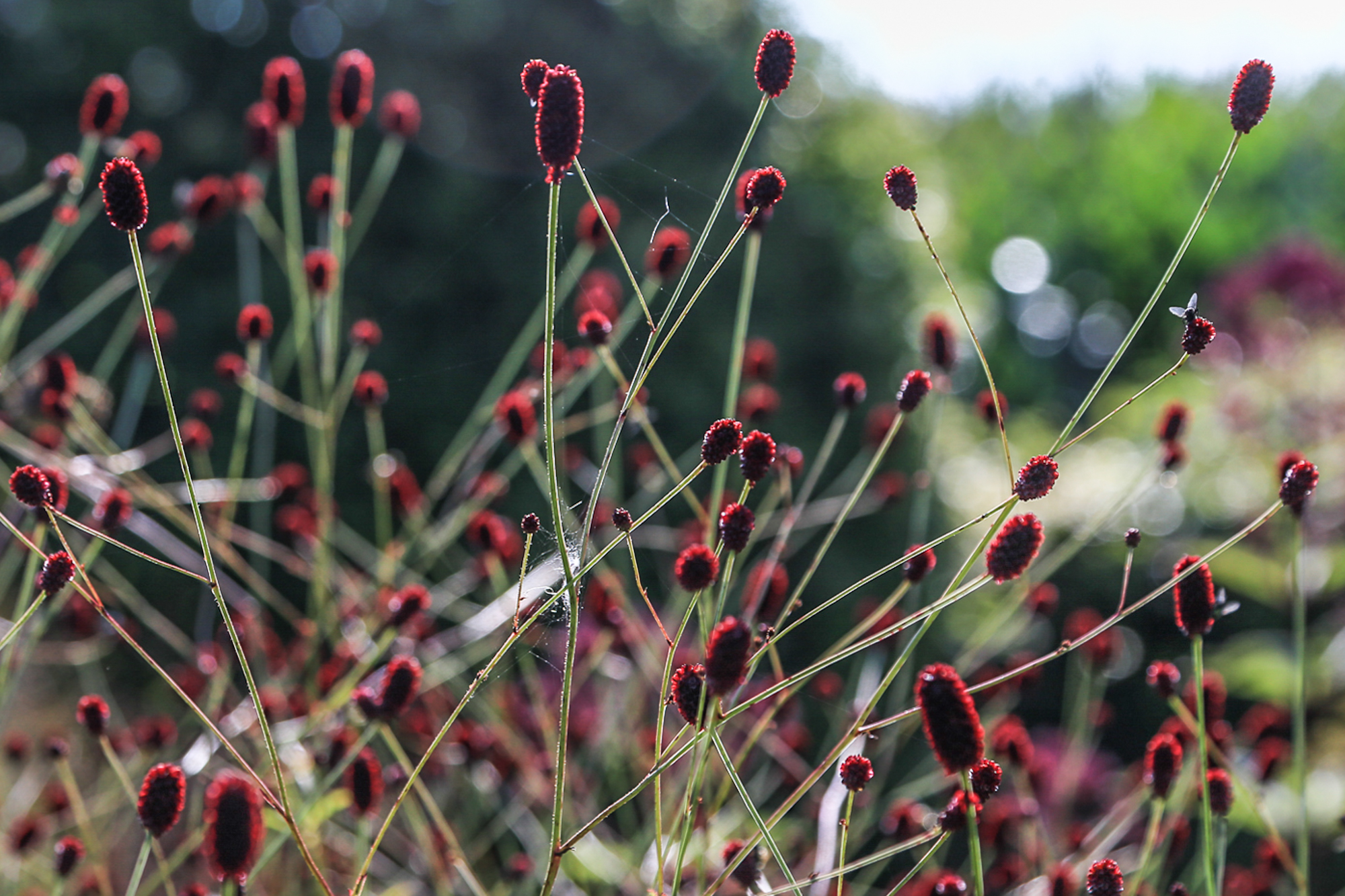 I've been in love with Piet Oudolf's gardens since I came across a copy of Designing with Plants by Oudolf and Noel Kingsbury while browsing in Barnes & Noble in 1999. I'd never before seen the kinds of startlingly romantic, lush, naturalistic, absolutely stunning plantings I found in that book. I was smitten, and I haven't gotten over it since. So when Carolyn Mullet, a well known garden designer from the DC area, gave me the opportunity to join her carexTours' Dutch Wave tour last August, I jumped at the chance.The carexTours itinerary was structured to give us a superb overview of Dutch Wave design, as well as glimpses into work of several other major garden designers in The Netherlands (and one in Germany), all packed into a week of two garden visits (sometimes three) each day. Come to think of it, we visited a couple of magnificent nurseries, a museum, a garden tool maker, and a palace too. Over the next few months, I'll be reporting on my own experience on this great tour.
I've been in love with Piet Oudolf's gardens since I came across a copy of Designing with Plants by Oudolf and Noel Kingsbury while browsing in Barnes & Noble in 1999. I'd never before seen the kinds of startlingly romantic, lush, naturalistic, absolutely stunning plantings I found in that book. I was smitten, and I haven't gotten over it since. So when Carolyn Mullet, a well known garden designer from the DC area, gave me the opportunity to join her carexTours' Dutch Wave tour last August, I jumped at the chance.The carexTours itinerary was structured to give us a superb overview of Dutch Wave design, as well as glimpses into work of several other major garden designers in The Netherlands (and one in Germany), all packed into a week of two garden visits (sometimes three) each day. Come to think of it, we visited a couple of magnificent nurseries, a museum, a garden tool maker, and a palace too. Over the next few months, I'll be reporting on my own experience on this great tour.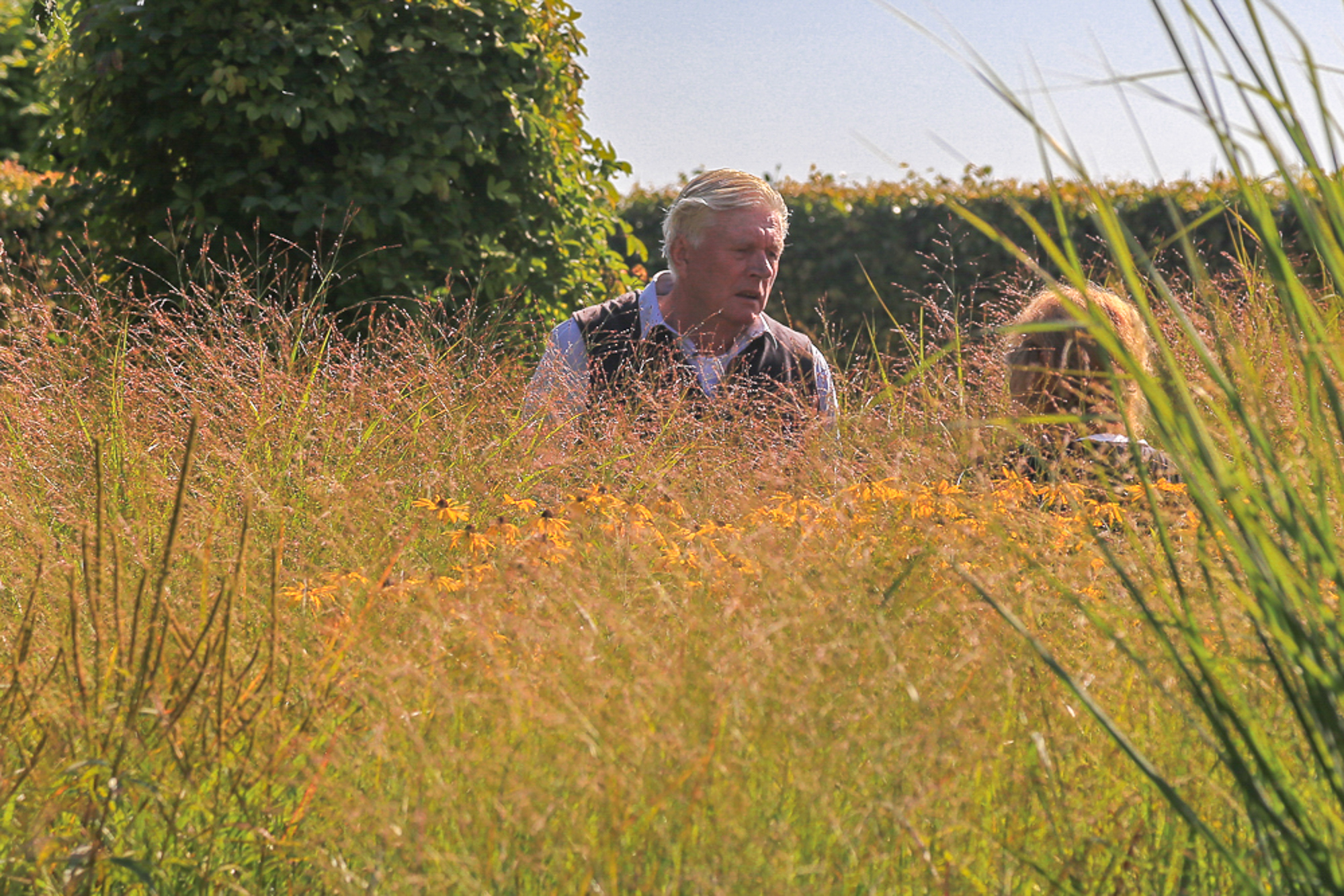 Unlike many staid and rather academic garden tours, Carolyn's was a hoot. She collected a really fun group of simpatico designers, garden makers and nursery owners from Canada, Sweden, Lithuania, Greece, the UK, Australia, Tasmania, and the US. The international appeal of the Dutch Wave style was certainly evident in the geographical diversity of our band of travelers. I can't remember ever having such a good time touring gardens.Since Piet Oudolf is the leading proponent of the Dutch Wave style (he more-or-less invented it), this post is about my first visit to Piet Oudolf's home garden, Hummelo--the 'omphalos' of Dutch Wave gardens. We also visited two other gardens designed by Oudolf--Vlinderhof, an extraordinary and relatively new public garden, and a small private garden none of us had heard of before, Tuin aan het Weeltje (this was the favorite of some)--but I'll describe our experience at those gardens later.Hummelo is particularly important because it is Oudolf's home garden and the place where he experiments and trials plants, and where his wife Anja operated a very famous nursery for many years.
Unlike many staid and rather academic garden tours, Carolyn's was a hoot. She collected a really fun group of simpatico designers, garden makers and nursery owners from Canada, Sweden, Lithuania, Greece, the UK, Australia, Tasmania, and the US. The international appeal of the Dutch Wave style was certainly evident in the geographical diversity of our band of travelers. I can't remember ever having such a good time touring gardens.Since Piet Oudolf is the leading proponent of the Dutch Wave style (he more-or-less invented it), this post is about my first visit to Piet Oudolf's home garden, Hummelo--the 'omphalos' of Dutch Wave gardens. We also visited two other gardens designed by Oudolf--Vlinderhof, an extraordinary and relatively new public garden, and a small private garden none of us had heard of before, Tuin aan het Weeltje (this was the favorite of some)--but I'll describe our experience at those gardens later.Hummelo is particularly important because it is Oudolf's home garden and the place where he experiments and trials plants, and where his wife Anja operated a very famous nursery for many years.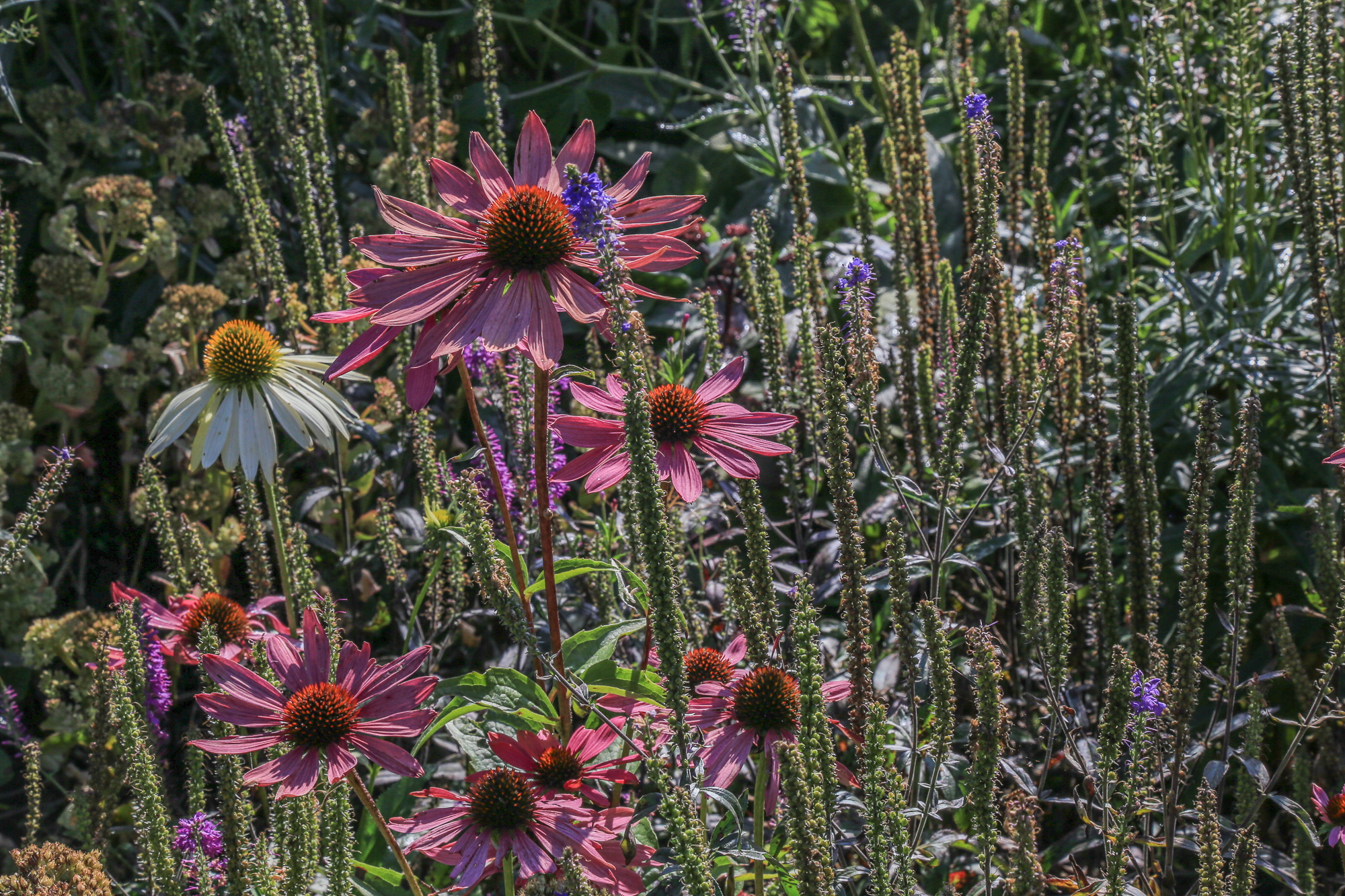 When the carexTours coach dropped us off at the end of Piet's driveway, and we walked to the house entrance, everyone was full of anticipation, perhaps even a little nervous. We were about to meet "the man".
When the carexTours coach dropped us off at the end of Piet's driveway, and we walked to the house entrance, everyone was full of anticipation, perhaps even a little nervous. We were about to meet "the man". Piet is typically Dutch, not one to brag about being one of the most famous garden designers on the face of the earth, certainly not a glad hander in the American style, actually rather reticent to mix it up with a bunch of strangers, but we quickly discovered a man of generous spirit who became intensely engaged when asked a question about plants, and gave far more than we had reason to expect. I wasn't watching the clock, but it seemed he spent the whole of about two hours with us.
Piet is typically Dutch, not one to brag about being one of the most famous garden designers on the face of the earth, certainly not a glad hander in the American style, actually rather reticent to mix it up with a bunch of strangers, but we quickly discovered a man of generous spirit who became intensely engaged when asked a question about plants, and gave far more than we had reason to expect. I wasn't watching the clock, but it seemed he spent the whole of about two hours with us. After a brief introduction and Q&A to get a feeling for who we were as individuals, Piet took us to the garden in front of his house. One of the first things he showed us was this 25-year-old border, evidence that the Dutch Wave--or 'New Perennials' style as it's known by many--can result in highly stable plantings if the appropriate plants are used in the right place. Behind the border you can see parts of the great hedges that make a formal contrast with the wild exuberance of the plantings.
After a brief introduction and Q&A to get a feeling for who we were as individuals, Piet took us to the garden in front of his house. One of the first things he showed us was this 25-year-old border, evidence that the Dutch Wave--or 'New Perennials' style as it's known by many--can result in highly stable plantings if the appropriate plants are used in the right place. Behind the border you can see parts of the great hedges that make a formal contrast with the wild exuberance of the plantings. We roamed freely, looking at plants and plant communities, frequently asking Piet the name of a plant, questions about why he designed a planting in a certain way, or about the history of the garden.
We roamed freely, looking at plants and plant communities, frequently asking Piet the name of a plant, questions about why he designed a planting in a certain way, or about the history of the garden.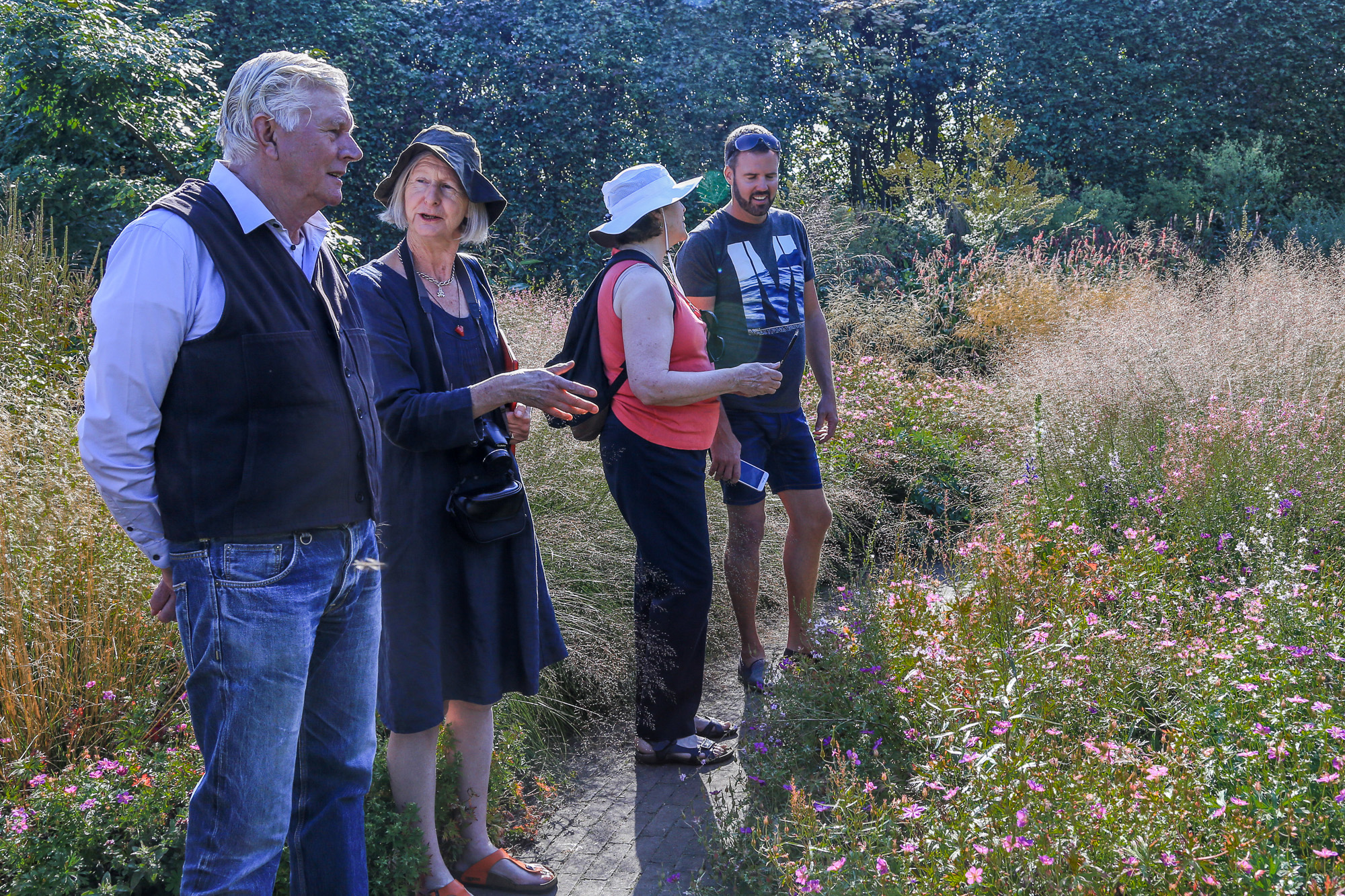 He told us it had been a rather rough summer in the front garden. Too much rain, combined with a naturally high water table, had damaged some plantings and outright killed all his Baptisias. This was a familiar story to some of us who already knew his famous "wavy" hedges had been removed a few years before for the same reason--high groundwater.The front garden, and I'm judging only from images I've seen of the garden over the years, appears to be much more thickly planted now than in the past, with a lot of block planting and quite a bit of mixed planting too. Piet told us that he's letting the plants take the lead in the back garden, and intervening minimally, but it appears some of this freer approach may be the practice in the front garden too. He does experiment constantly.
He told us it had been a rather rough summer in the front garden. Too much rain, combined with a naturally high water table, had damaged some plantings and outright killed all his Baptisias. This was a familiar story to some of us who already knew his famous "wavy" hedges had been removed a few years before for the same reason--high groundwater.The front garden, and I'm judging only from images I've seen of the garden over the years, appears to be much more thickly planted now than in the past, with a lot of block planting and quite a bit of mixed planting too. Piet told us that he's letting the plants take the lead in the back garden, and intervening minimally, but it appears some of this freer approach may be the practice in the front garden too. He does experiment constantly.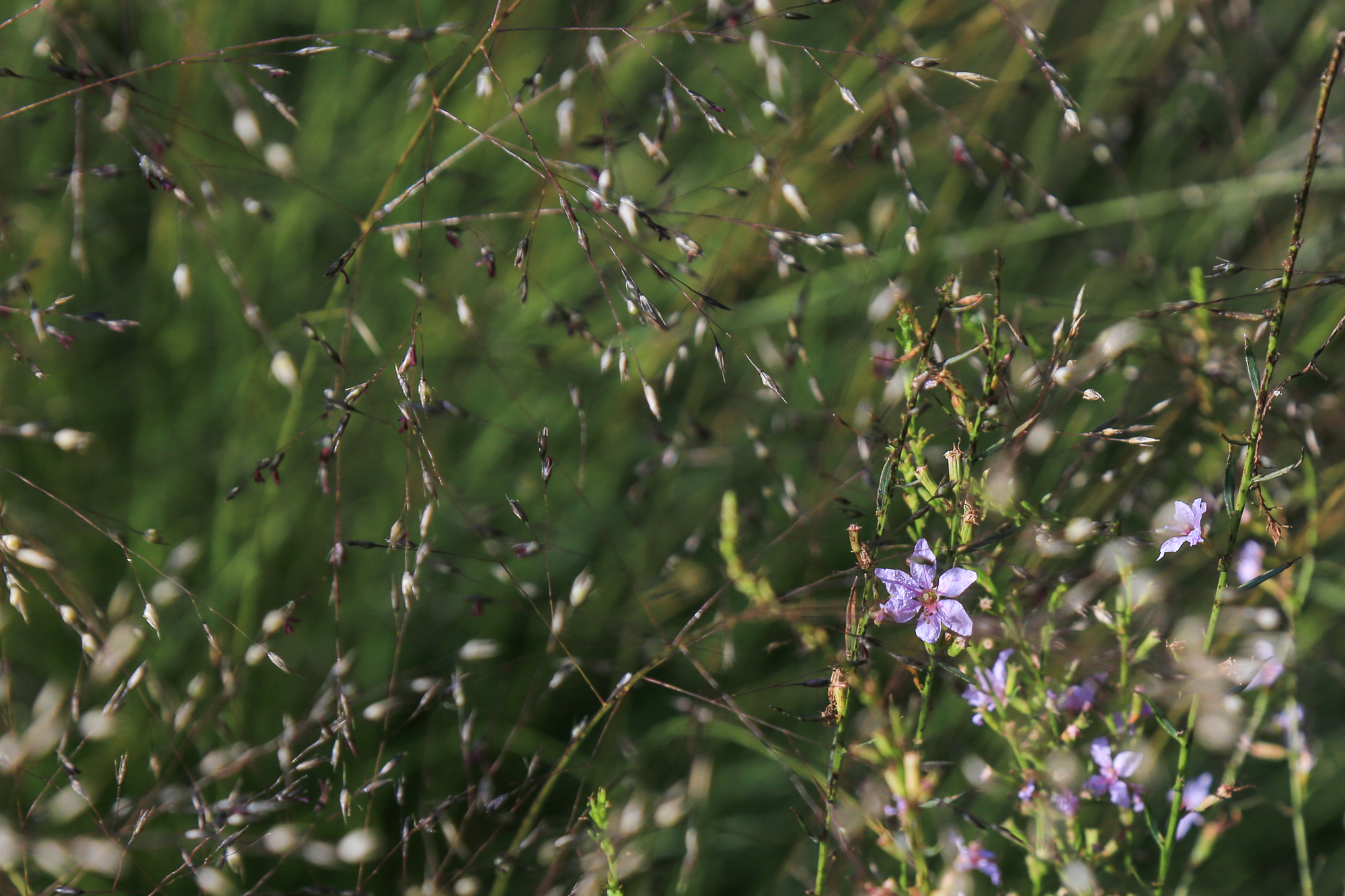 Piet also told us he has found that Sporobolus heterolepis (Prairie Dropseed) performs so well in his conditions that he's using much more of it now than in the past. In fact, he's using it in place of several other grasses. There are billowing clouds of it in the front garden where it works almost as a matrix plant. You see masses of it, often mixed with flowering plants, such as the small, delicate flowers of a tiny lythrum (I think he said it was from Russia), as shown below ...
Piet also told us he has found that Sporobolus heterolepis (Prairie Dropseed) performs so well in his conditions that he's using much more of it now than in the past. In fact, he's using it in place of several other grasses. There are billowing clouds of it in the front garden where it works almost as a matrix plant. You see masses of it, often mixed with flowering plants, such as the small, delicate flowers of a tiny lythrum (I think he said it was from Russia), as shown below ...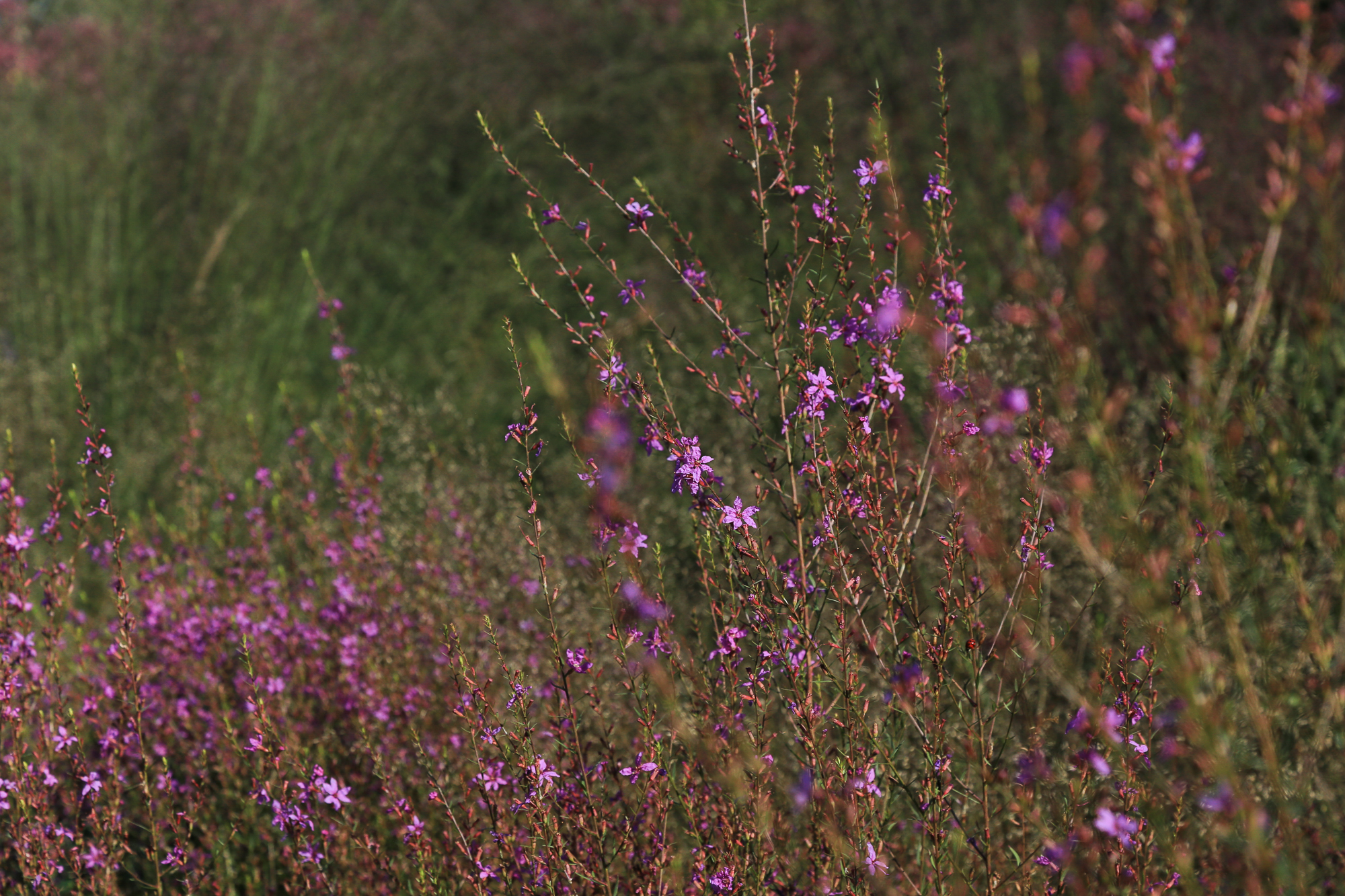 ... or in combinations with much bolder plants like bright red Helenium.
... or in combinations with much bolder plants like bright red Helenium. Big "camel-back" hedges have always been a prominent part of the border of Piet's garden. Here they enclose exuberant plantings rollicking like a sea surface of varied colors, forms, textures and shapes, accented by occasional spire-like emergents.
Big "camel-back" hedges have always been a prominent part of the border of Piet's garden. Here they enclose exuberant plantings rollicking like a sea surface of varied colors, forms, textures and shapes, accented by occasional spire-like emergents.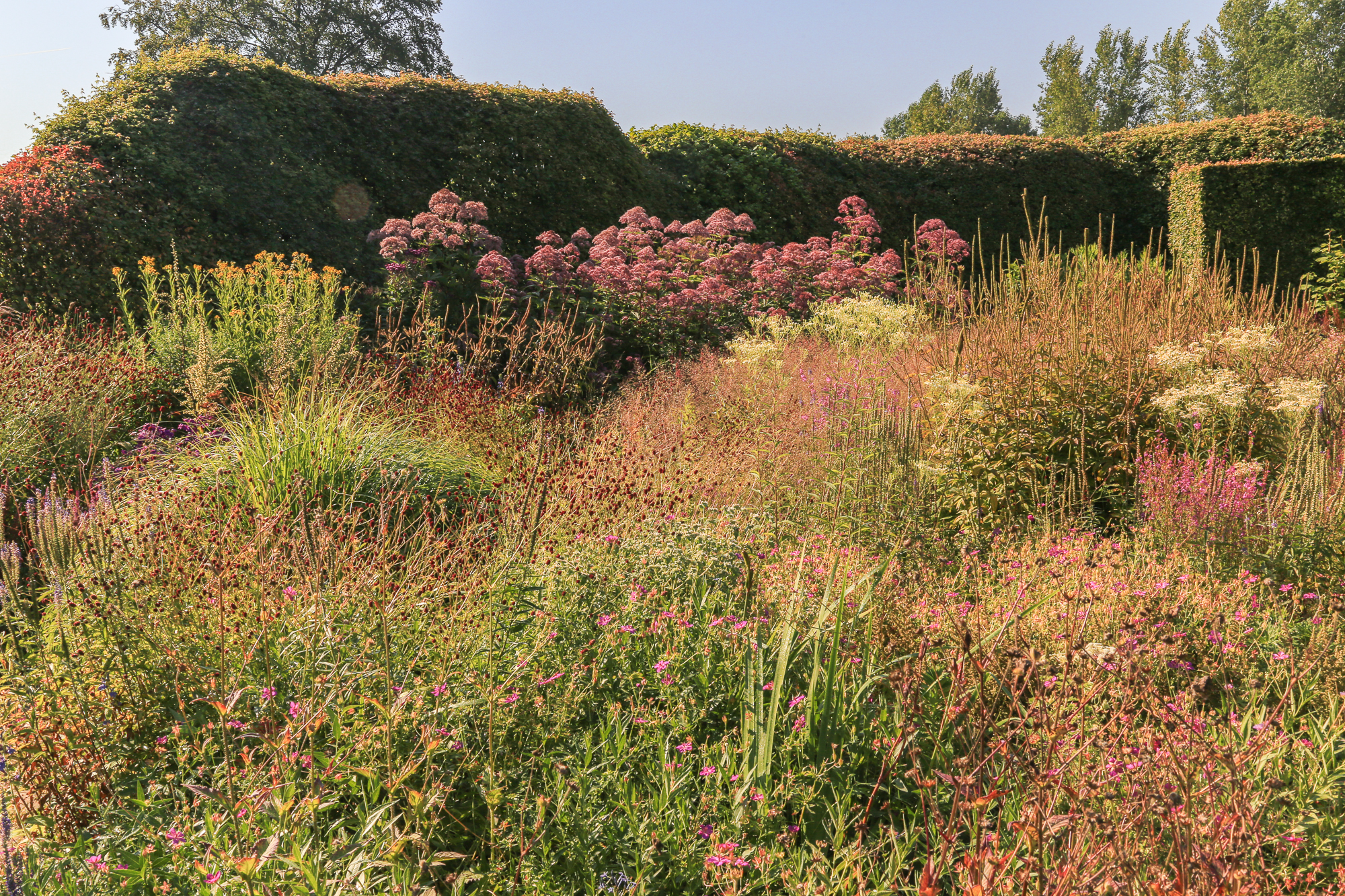 I particularly liked this simple planting of the dramatically flowing grass, Nasella tenuissima, and formal hedges right up against the front of the house--another example of contrast between billowy forms and straight edges.
I particularly liked this simple planting of the dramatically flowing grass, Nasella tenuissima, and formal hedges right up against the front of the house--another example of contrast between billowy forms and straight edges.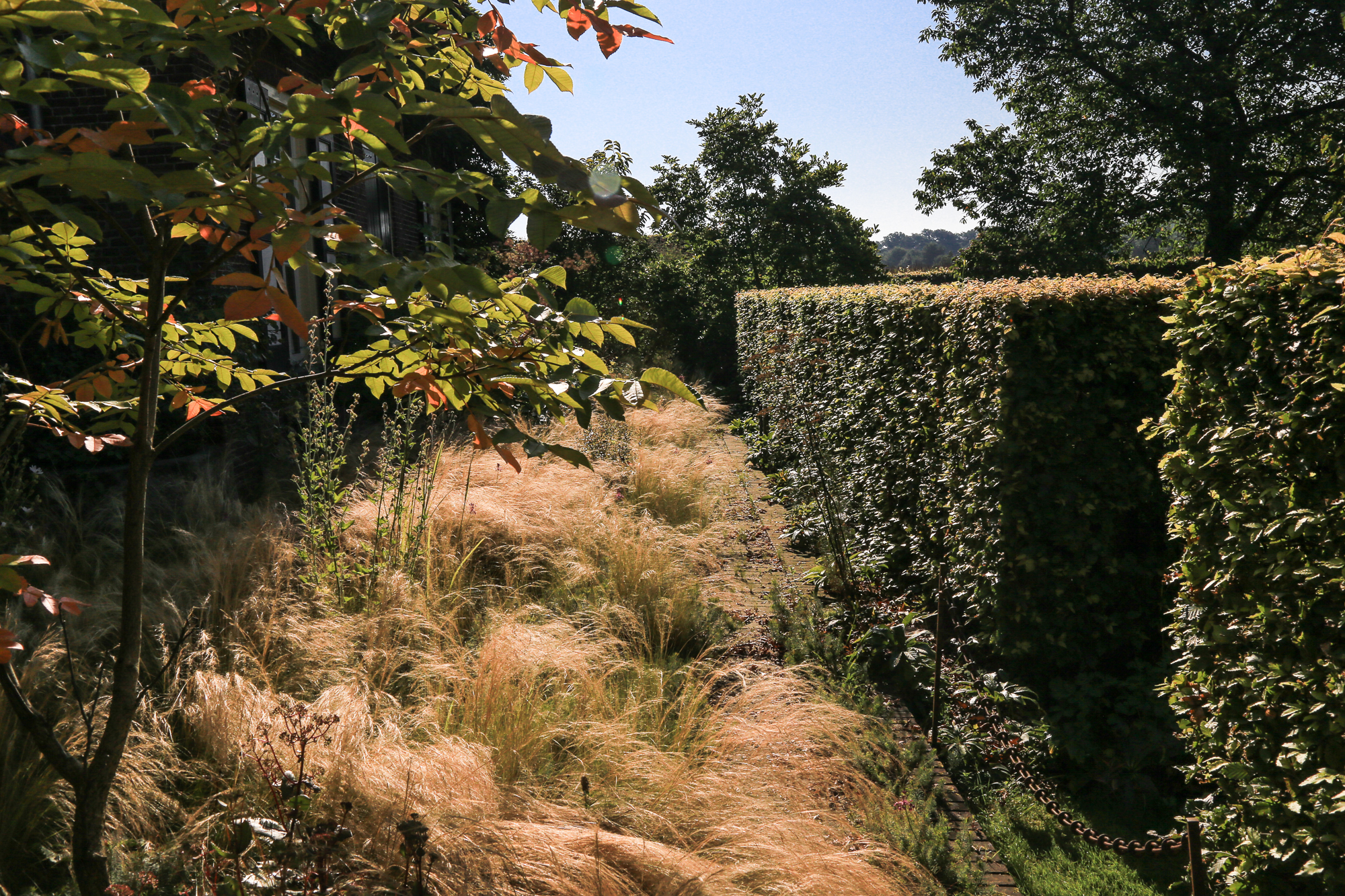 And another contrast below, with huge umbels of flowering Joe Pye Weed against delicate grass tracery.
And another contrast below, with huge umbels of flowering Joe Pye Weed against delicate grass tracery.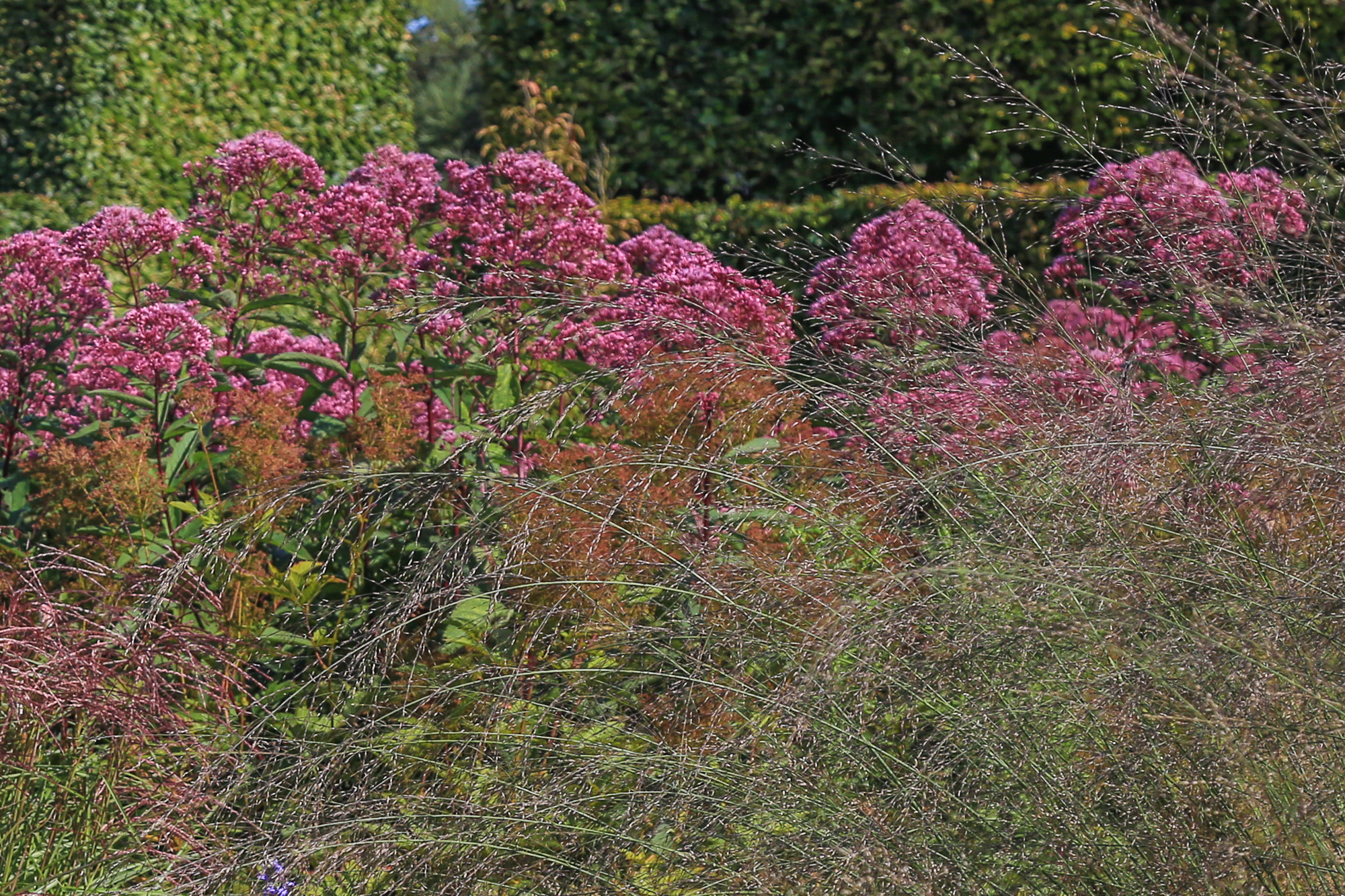 When you read about the importance of plant structure and seed heads in a Dutch Wave garden ...
When you read about the importance of plant structure and seed heads in a Dutch Wave garden ...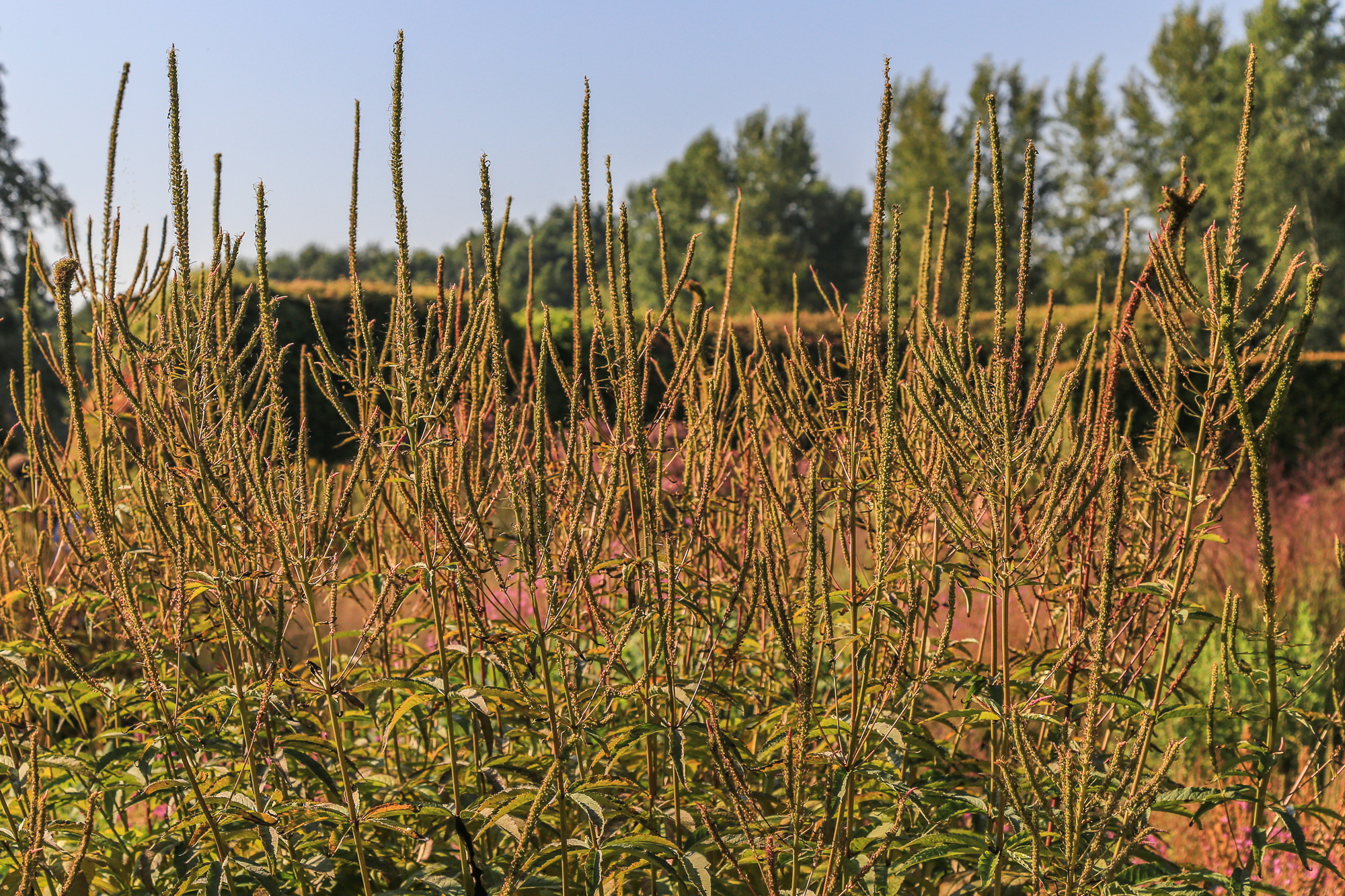 ... this is what is meant. This Veronicastrum virginicum flowered long ago and its stately, complex, symmetrical spire-like seed heads will help carry garden interest well into winter.
... this is what is meant. This Veronicastrum virginicum flowered long ago and its stately, complex, symmetrical spire-like seed heads will help carry garden interest well into winter.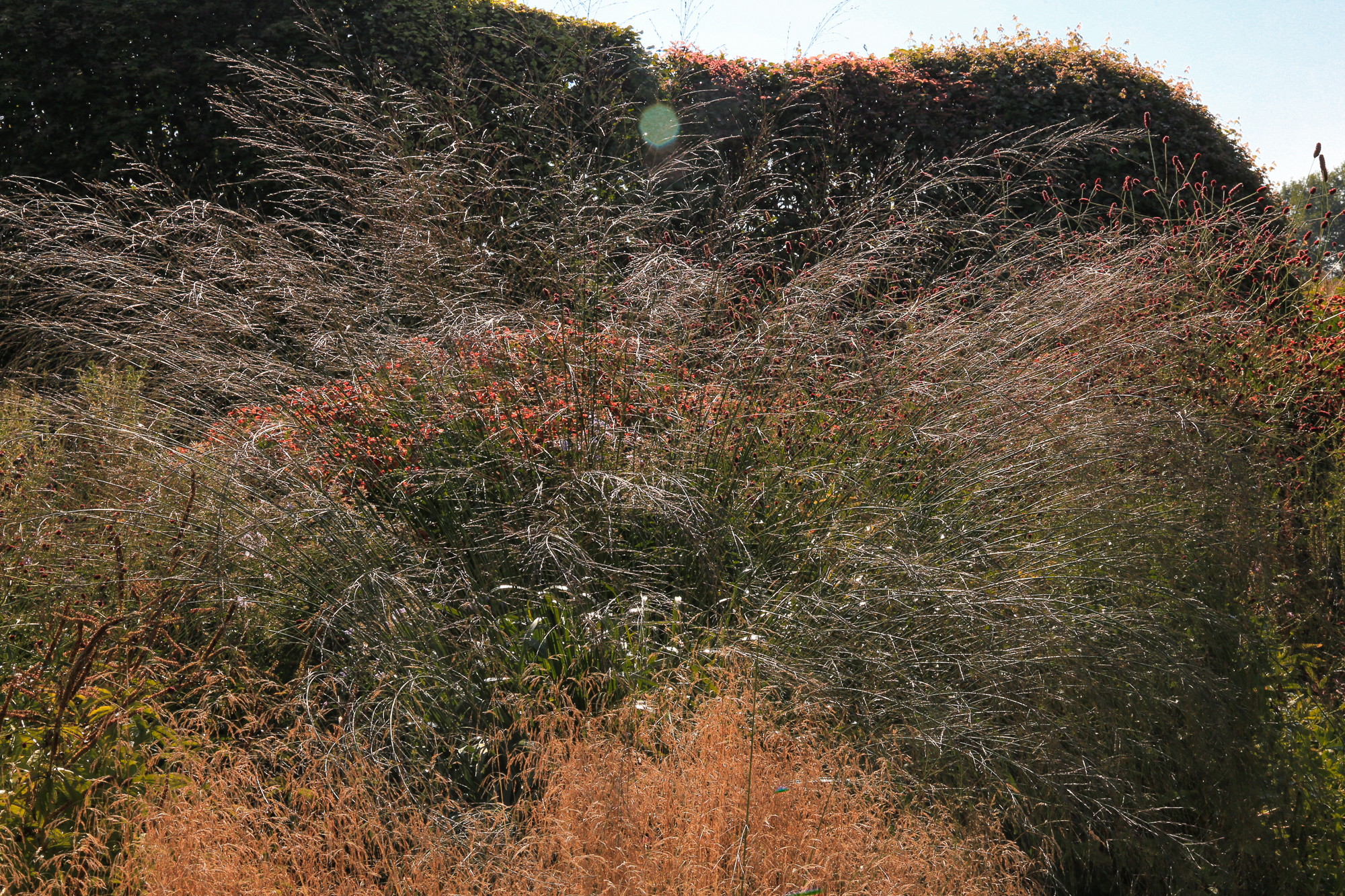 Above, an extraordinary effect of light combined with color and fragile grass form suggests a floral 'explosion' caught in the bright sunlight.
Above, an extraordinary effect of light combined with color and fragile grass form suggests a floral 'explosion' caught in the bright sunlight.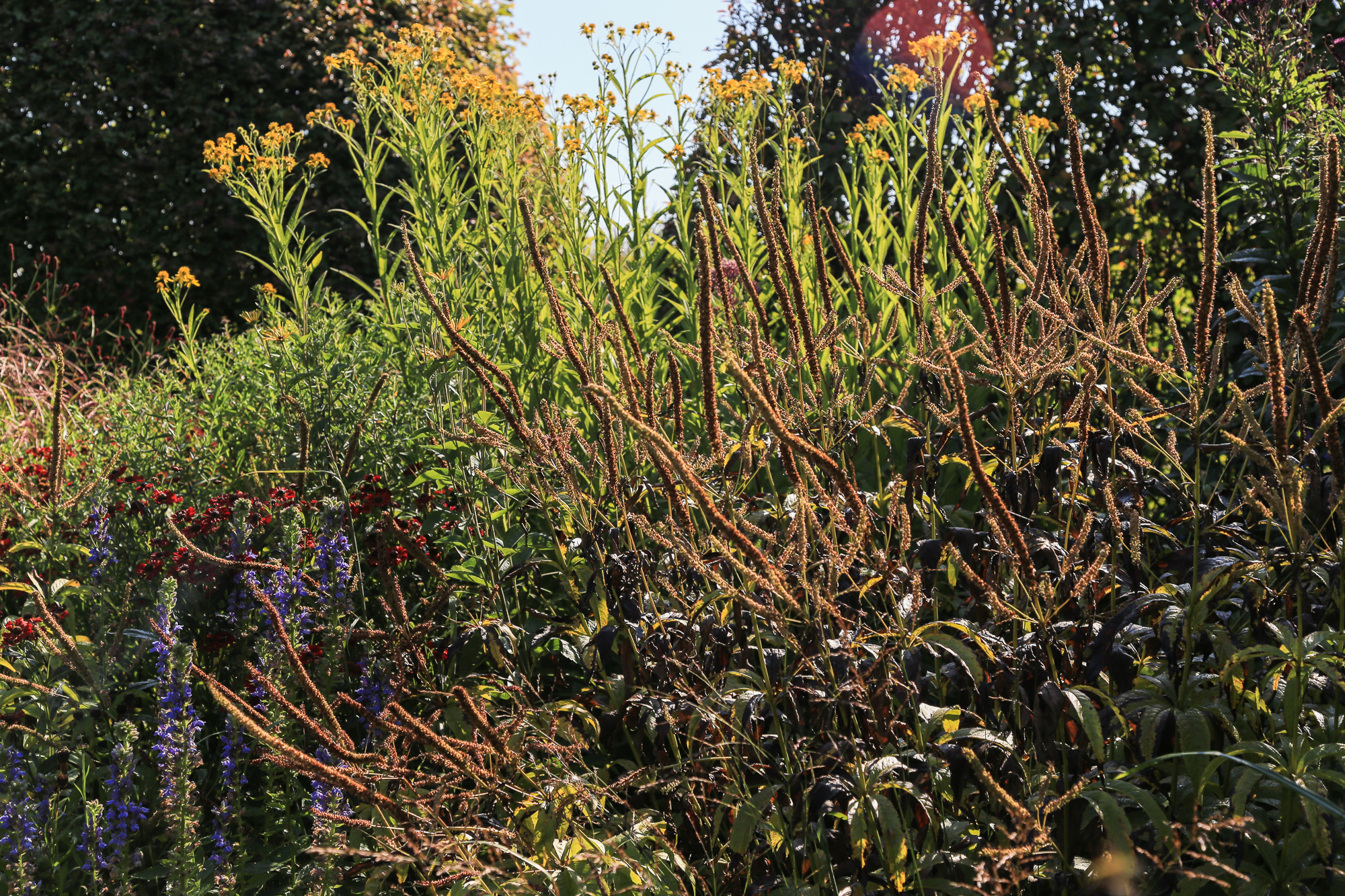 This complex arrangement of forms above shows the beauty of unusual plant combinations allowed to create their own dramatic surprises--here red Helenium, blue Lobelia syphilitica, tall Verbesina alternifolia, and the twisted, gothic squiggles of brown Veronicastrum virginicum seedheads. This is a masterful composition.Below, in the space between the front garden and the facade of the house, you get a sense of the greater openness of the early Hummelo.
This complex arrangement of forms above shows the beauty of unusual plant combinations allowed to create their own dramatic surprises--here red Helenium, blue Lobelia syphilitica, tall Verbesina alternifolia, and the twisted, gothic squiggles of brown Veronicastrum virginicum seedheads. This is a masterful composition.Below, in the space between the front garden and the facade of the house, you get a sense of the greater openness of the early Hummelo.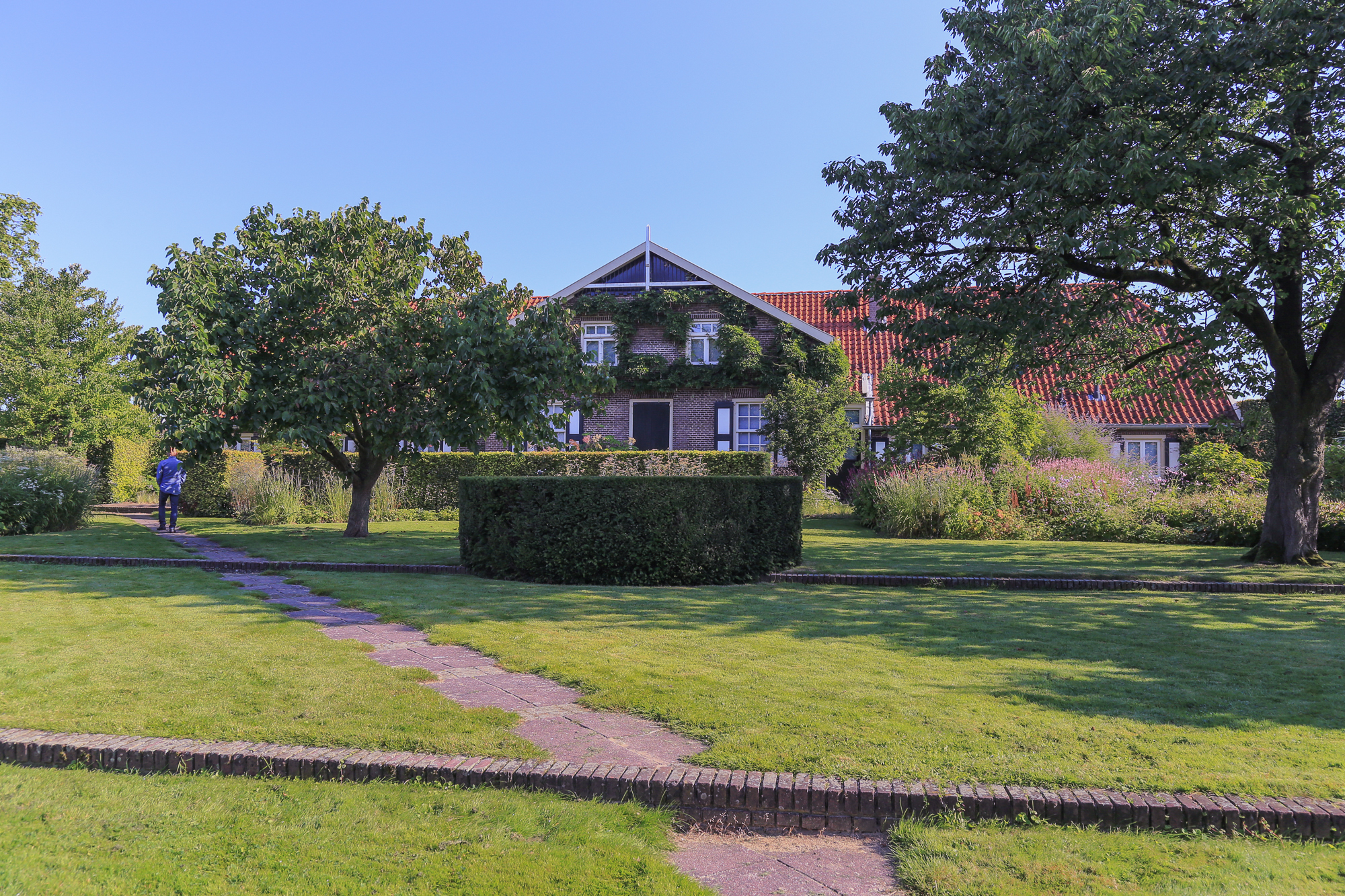 After stepping a few yards back into the front garden, much of that space seems to disappear in the fullness of the garden proper.
After stepping a few yards back into the front garden, much of that space seems to disappear in the fullness of the garden proper.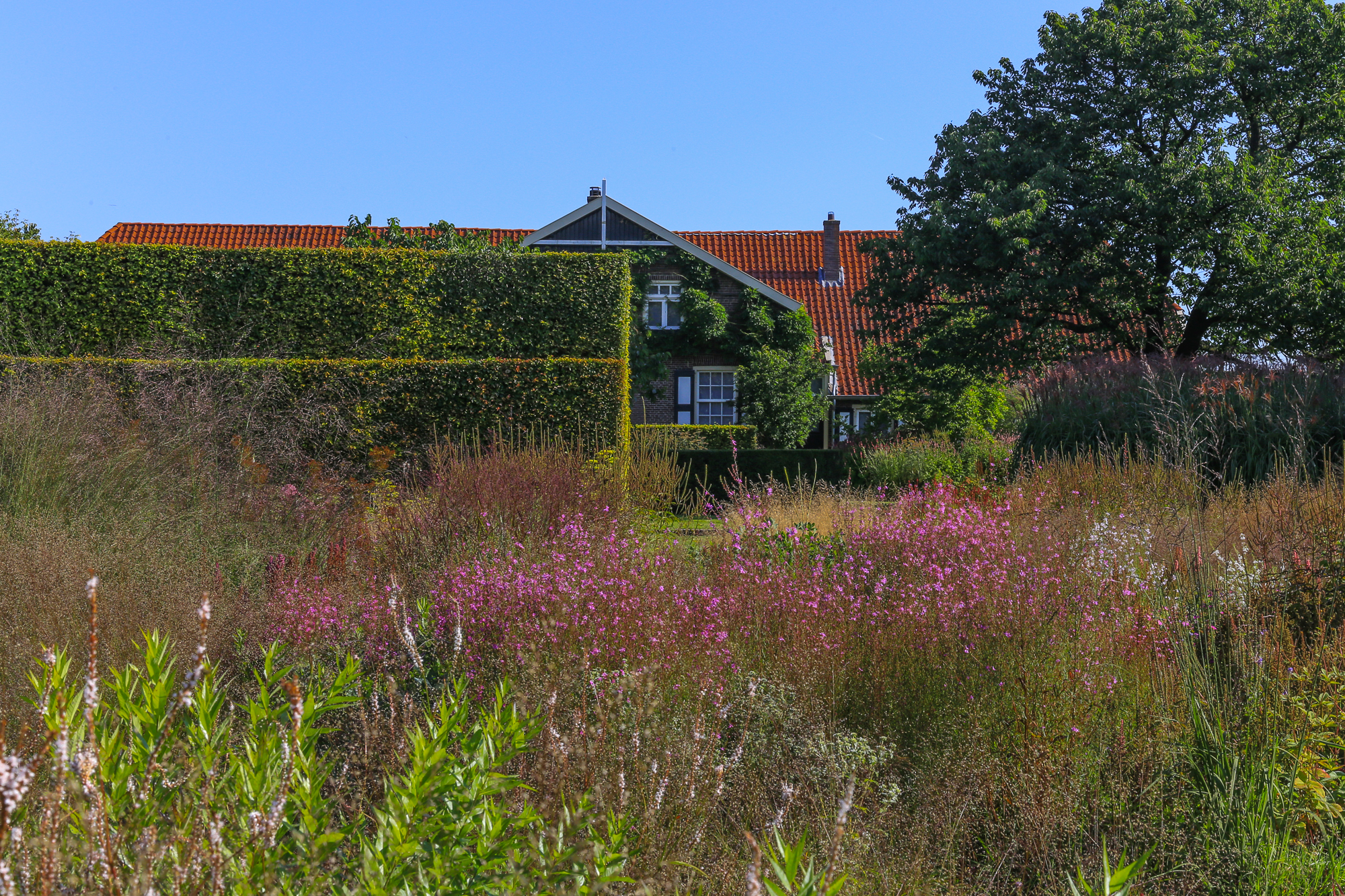 That large hedge you see is actually a tunnel. There's a great deal more going on here than I have space to explore in this blog post ...
That large hedge you see is actually a tunnel. There's a great deal more going on here than I have space to explore in this blog post ... ... because we still have to see the back garden, where the nursery used to be, and Piet's studio. Below, between the back of the house and the back garden, is a kind of perennial and grass anteroom, to give the visitor a kind of breathing space, analogous to a musical interlude, before plunging into the garden proper.
... because we still have to see the back garden, where the nursery used to be, and Piet's studio. Below, between the back of the house and the back garden, is a kind of perennial and grass anteroom, to give the visitor a kind of breathing space, analogous to a musical interlude, before plunging into the garden proper.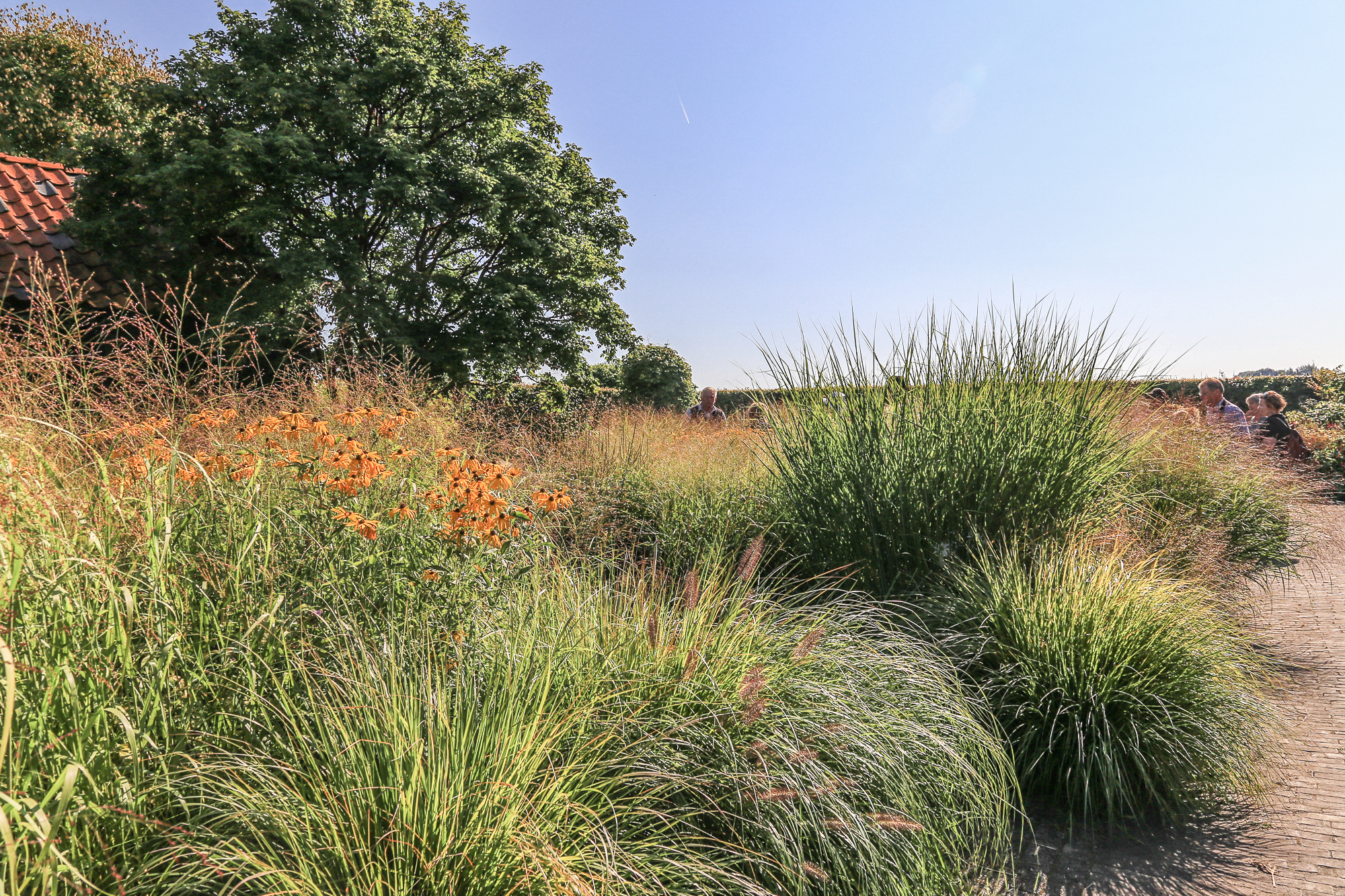 Piet invited the group to view the garden from above, and took us all up to the roof of the studio. This is what we saw.
Piet invited the group to view the garden from above, and took us all up to the roof of the studio. This is what we saw.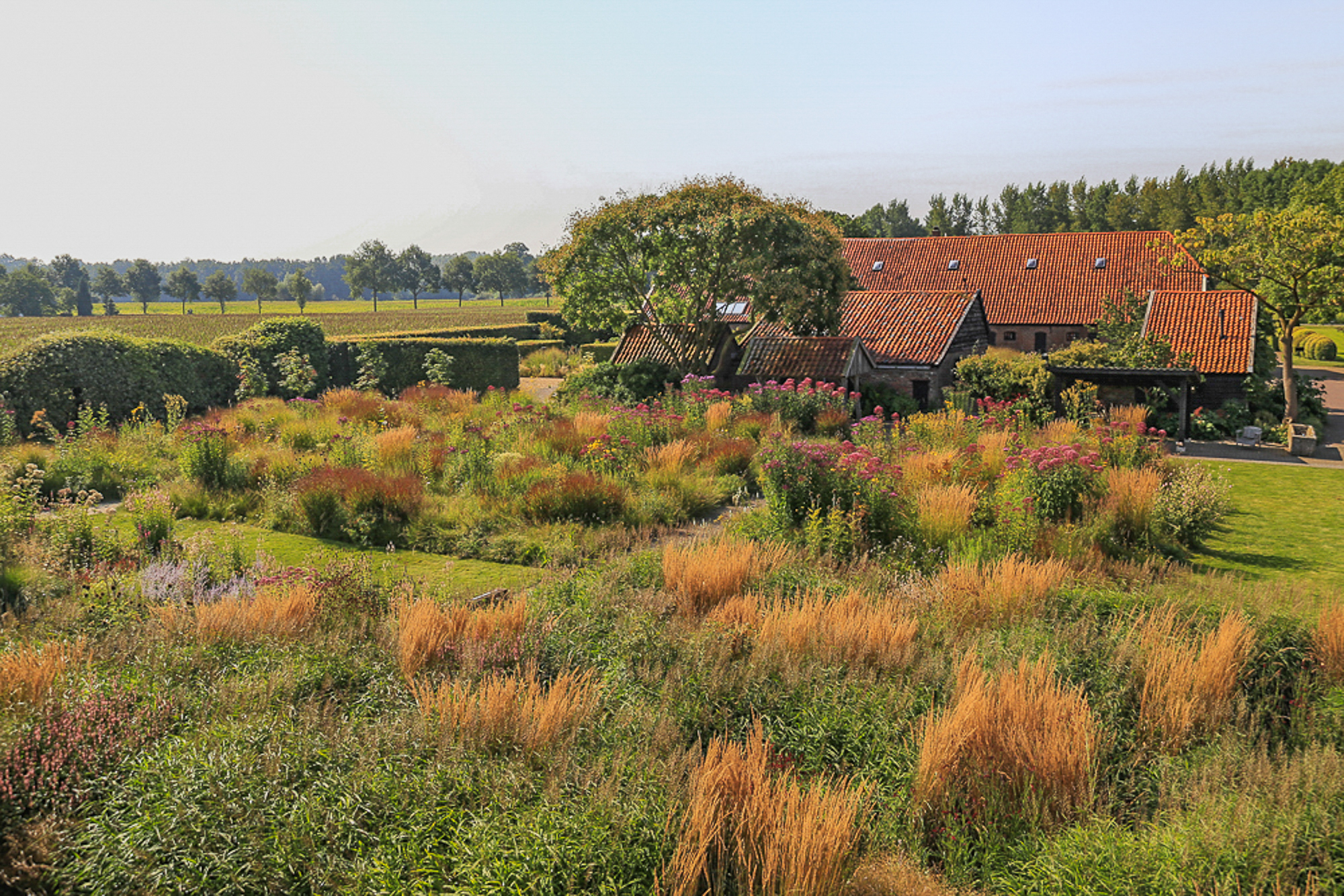 Though I'd never been in the garden before, I quite clearly remember photos of the back garden soon after the nursery had been cleared away and initial plantings had been completed. The garden then was much leaner, with Calamagrostis acutiflora 'Karl Foerester' used like sentinels throughout. Those Calamagrostis plantings have grown much larger and fuller now. You can see how their golden late summer color almost dominates at this time of year.
Though I'd never been in the garden before, I quite clearly remember photos of the back garden soon after the nursery had been cleared away and initial plantings had been completed. The garden then was much leaner, with Calamagrostis acutiflora 'Karl Foerester' used like sentinels throughout. Those Calamagrostis plantings have grown much larger and fuller now. You can see how their golden late summer color almost dominates at this time of year.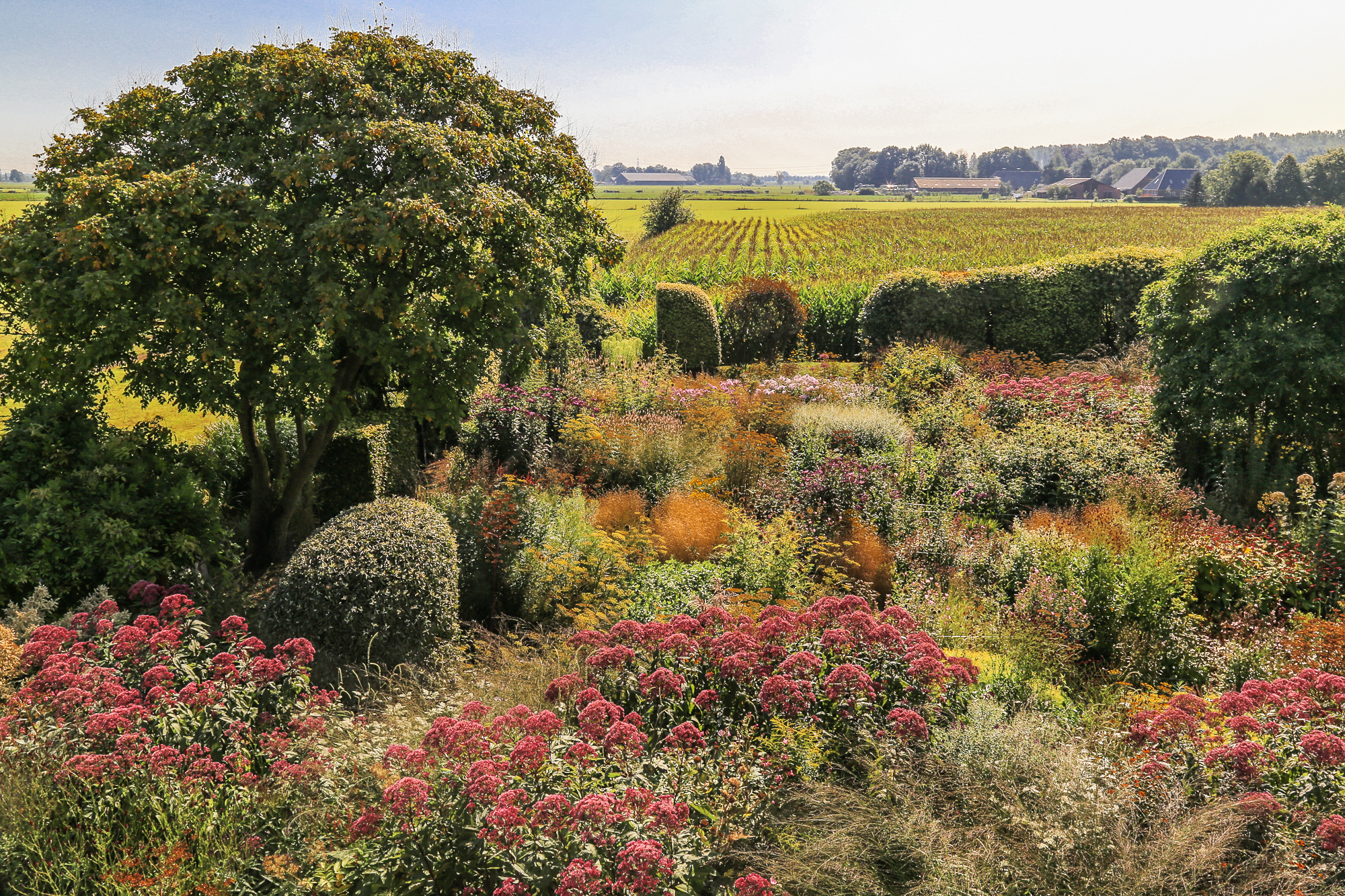 Above, the back garden looking from the other side of the studio roof. Large masses of Joe Pye Weed dominate near the studio but a huge variety of perennials and grasses compete in the space beyond.
Above, the back garden looking from the other side of the studio roof. Large masses of Joe Pye Weed dominate near the studio but a huge variety of perennials and grasses compete in the space beyond. Piet explained to us that he was trying something new in the back garden. If I understood him correctly, he's intentionally letting the garden go, allowing the plants to intermingle and compete, just to see what will happen. He's always experimenting, and you can be sure he intervenes when he thinks it appropriate.
Piet explained to us that he was trying something new in the back garden. If I understood him correctly, he's intentionally letting the garden go, allowing the plants to intermingle and compete, just to see what will happen. He's always experimenting, and you can be sure he intervenes when he thinks it appropriate.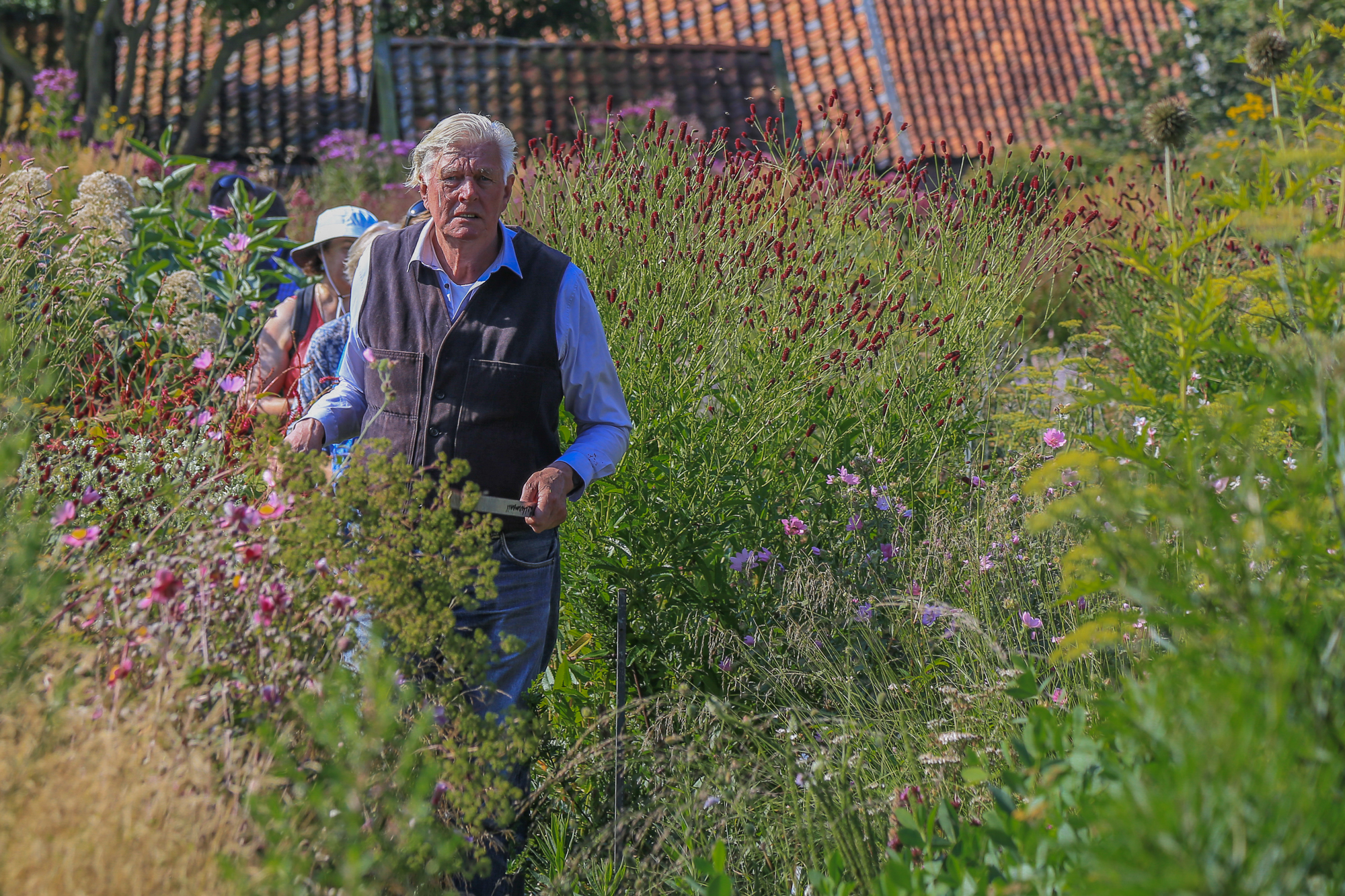 Here Piet Oudolf is plunging through the garden, members of our troop straggling behind him (he's a tall man with a long, fast gait). Note the tall, thick plantings.
Here Piet Oudolf is plunging through the garden, members of our troop straggling behind him (he's a tall man with a long, fast gait). Note the tall, thick plantings.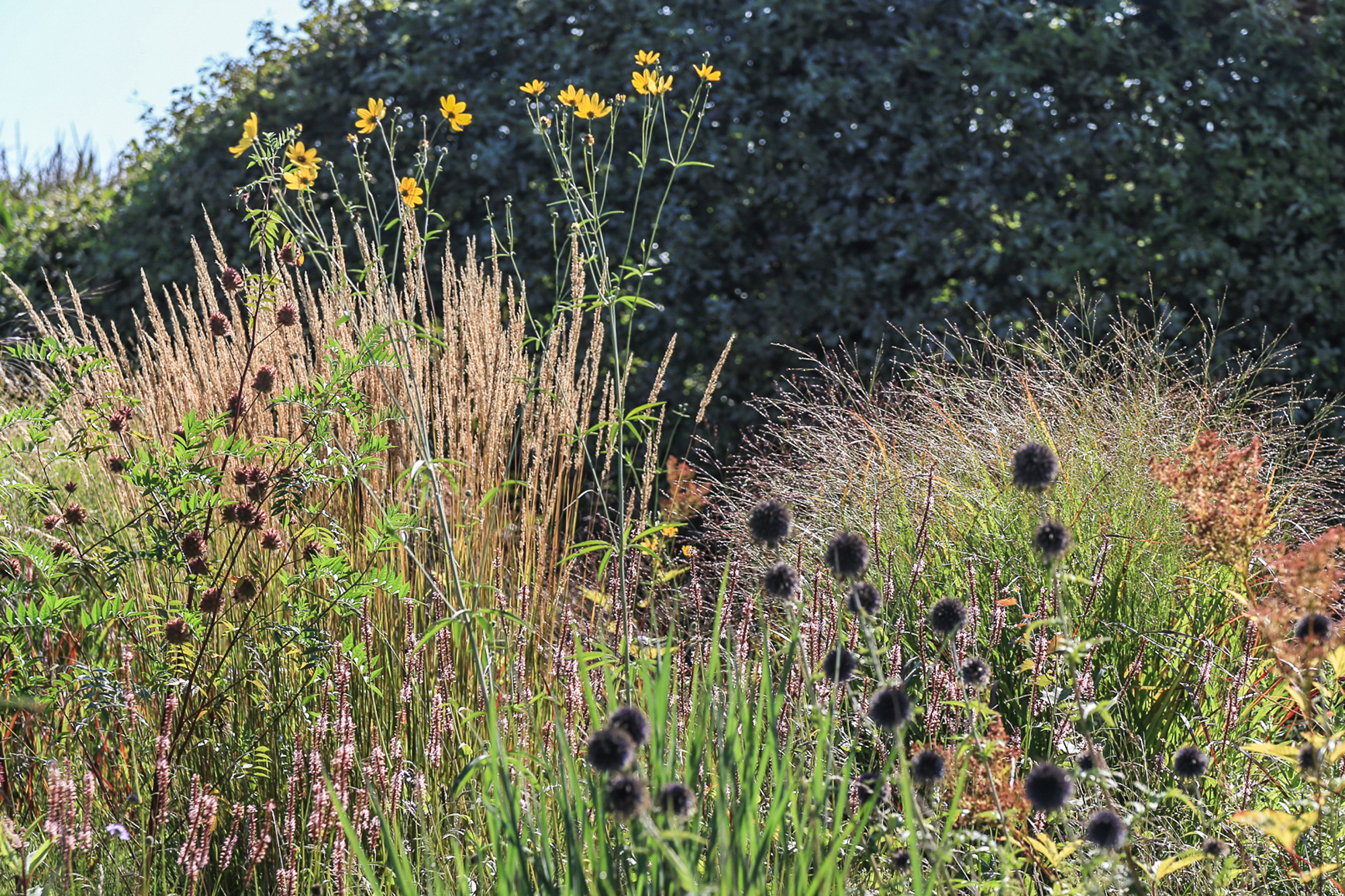 This figure below is not a statue, it's a painted cut-out, a remembrance of the old nursery, Kwekerij Oudolf.
This figure below is not a statue, it's a painted cut-out, a remembrance of the old nursery, Kwekerij Oudolf.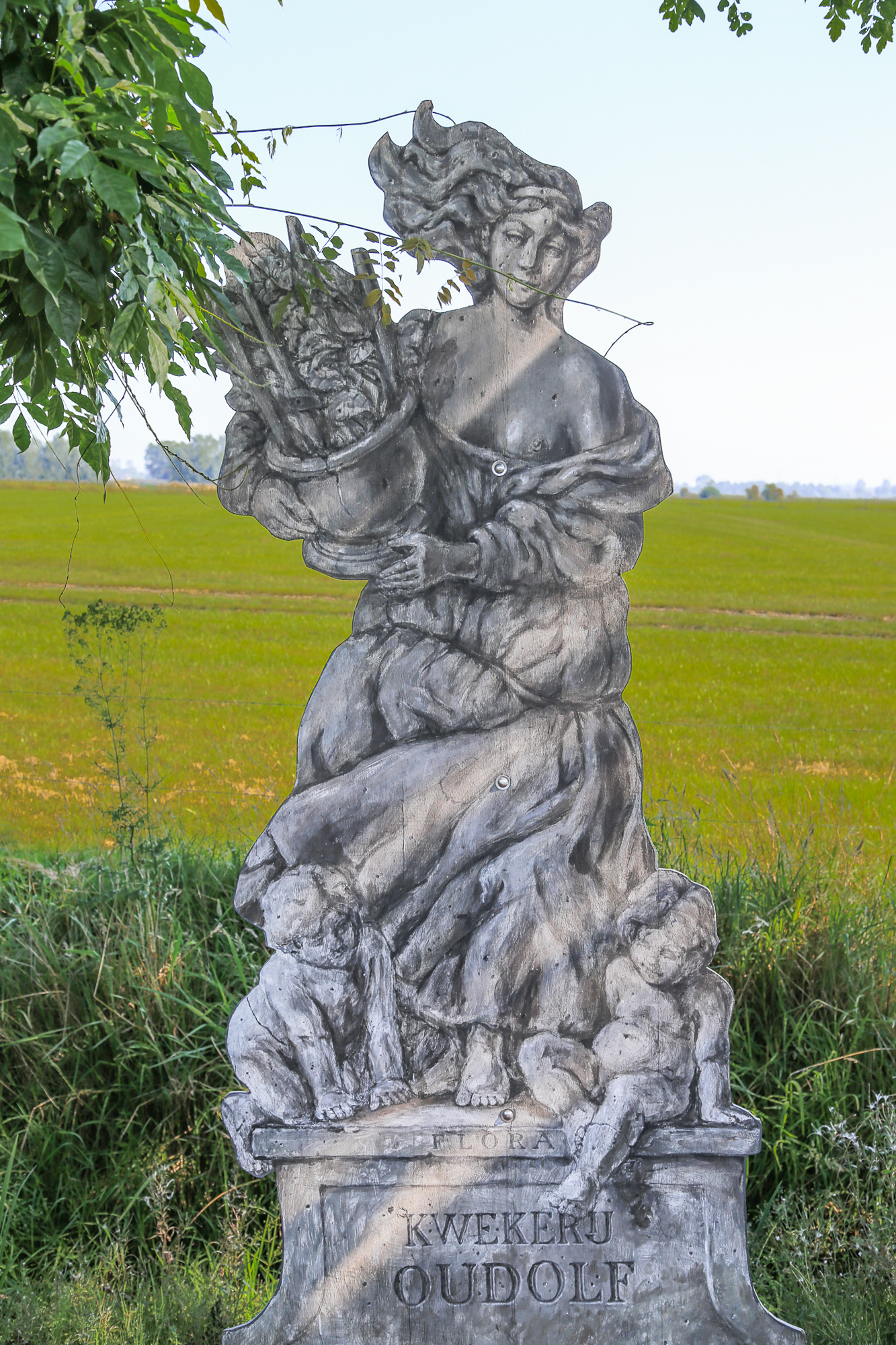 And here is the studio, quite an attractive building ...
And here is the studio, quite an attractive building ...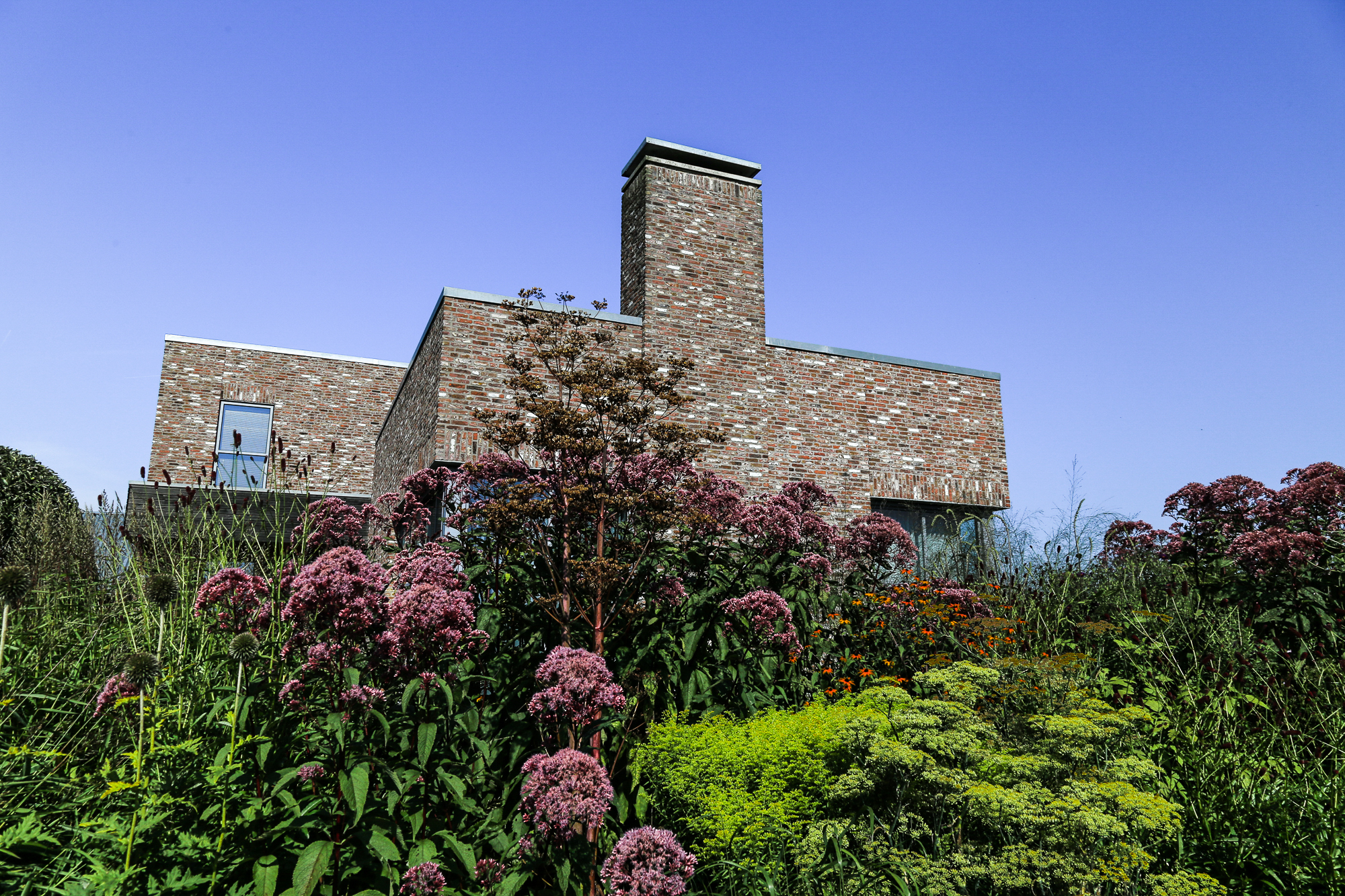 ... banked on this side by tall, flowering plants ...
... banked on this side by tall, flowering plants ...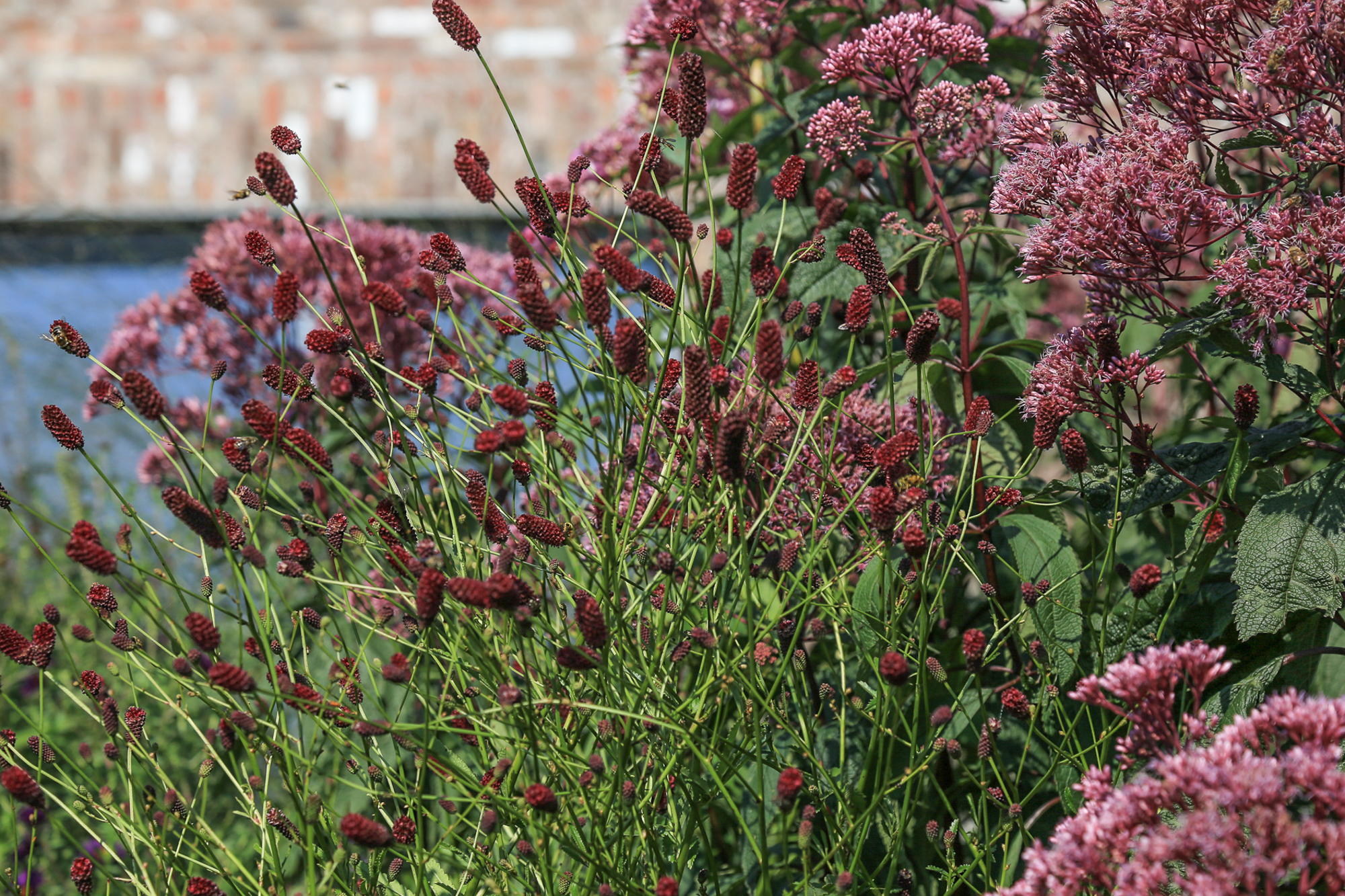
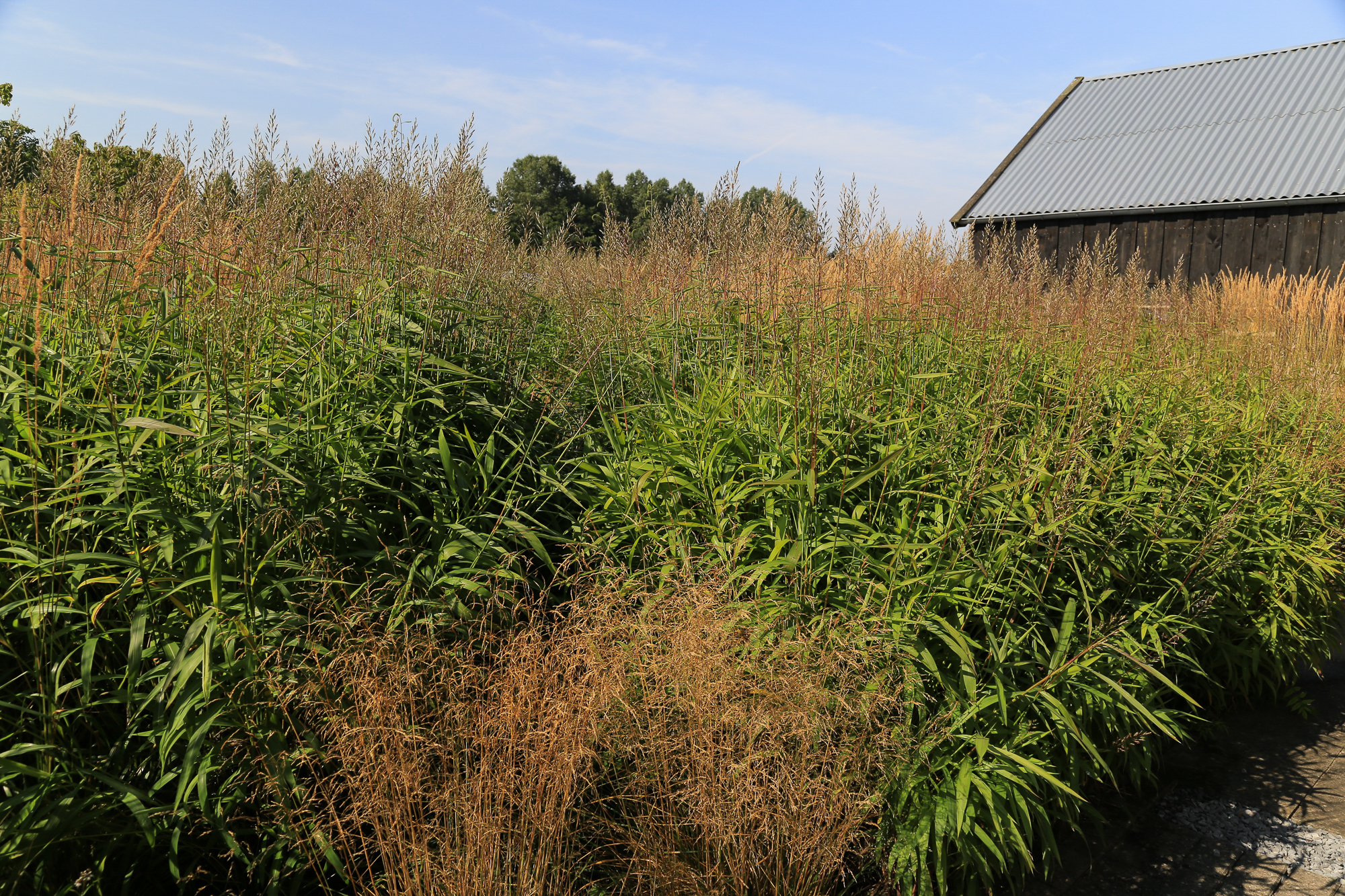 ... and on the entry side, by massed grasses, here Spodiopogon sibericus (a grass not used frequently enough) ...
... and on the entry side, by massed grasses, here Spodiopogon sibericus (a grass not used frequently enough) ...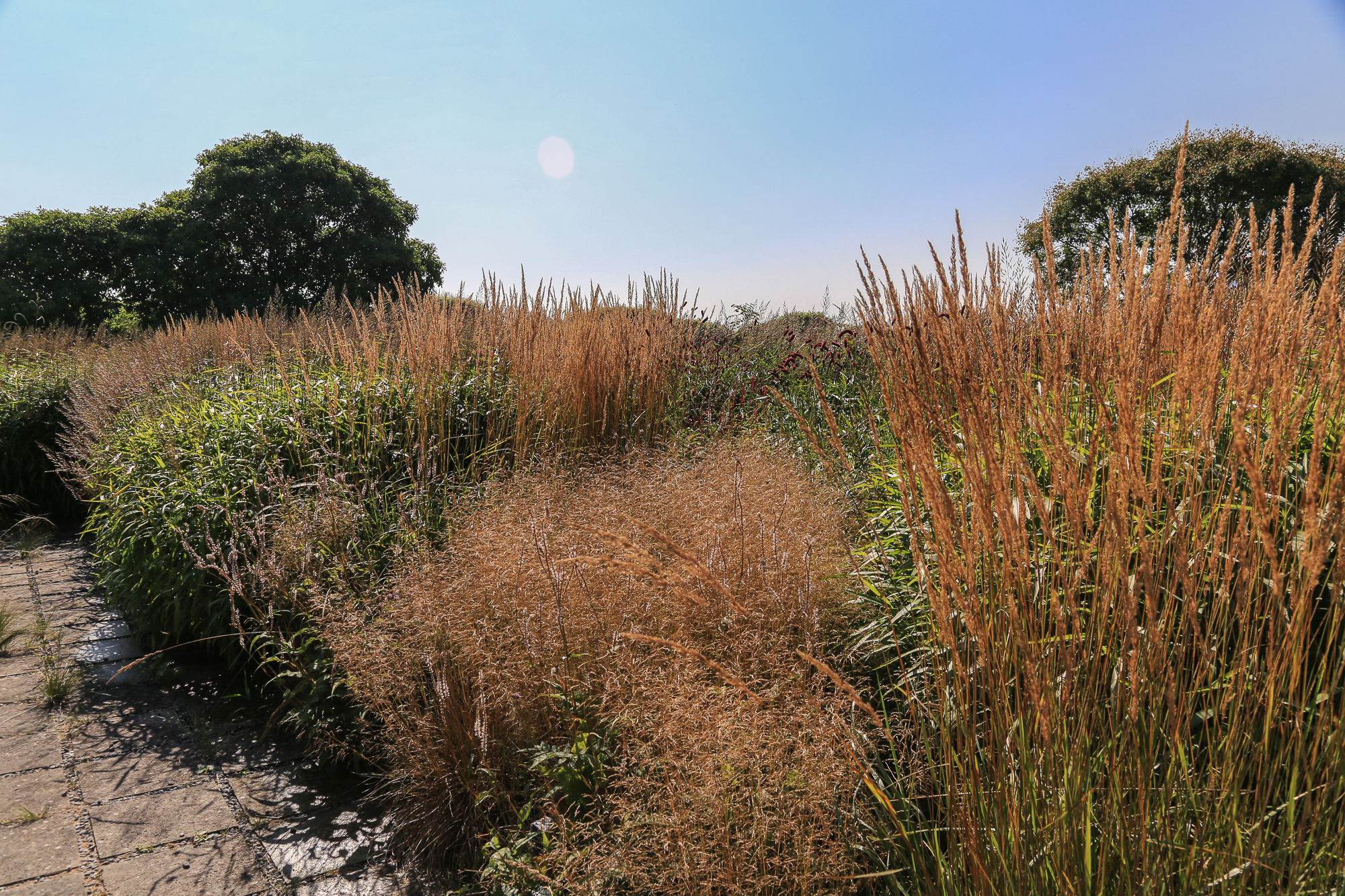 ... with Calamagrostis and some Deschampsia in front.
... with Calamagrostis and some Deschampsia in front.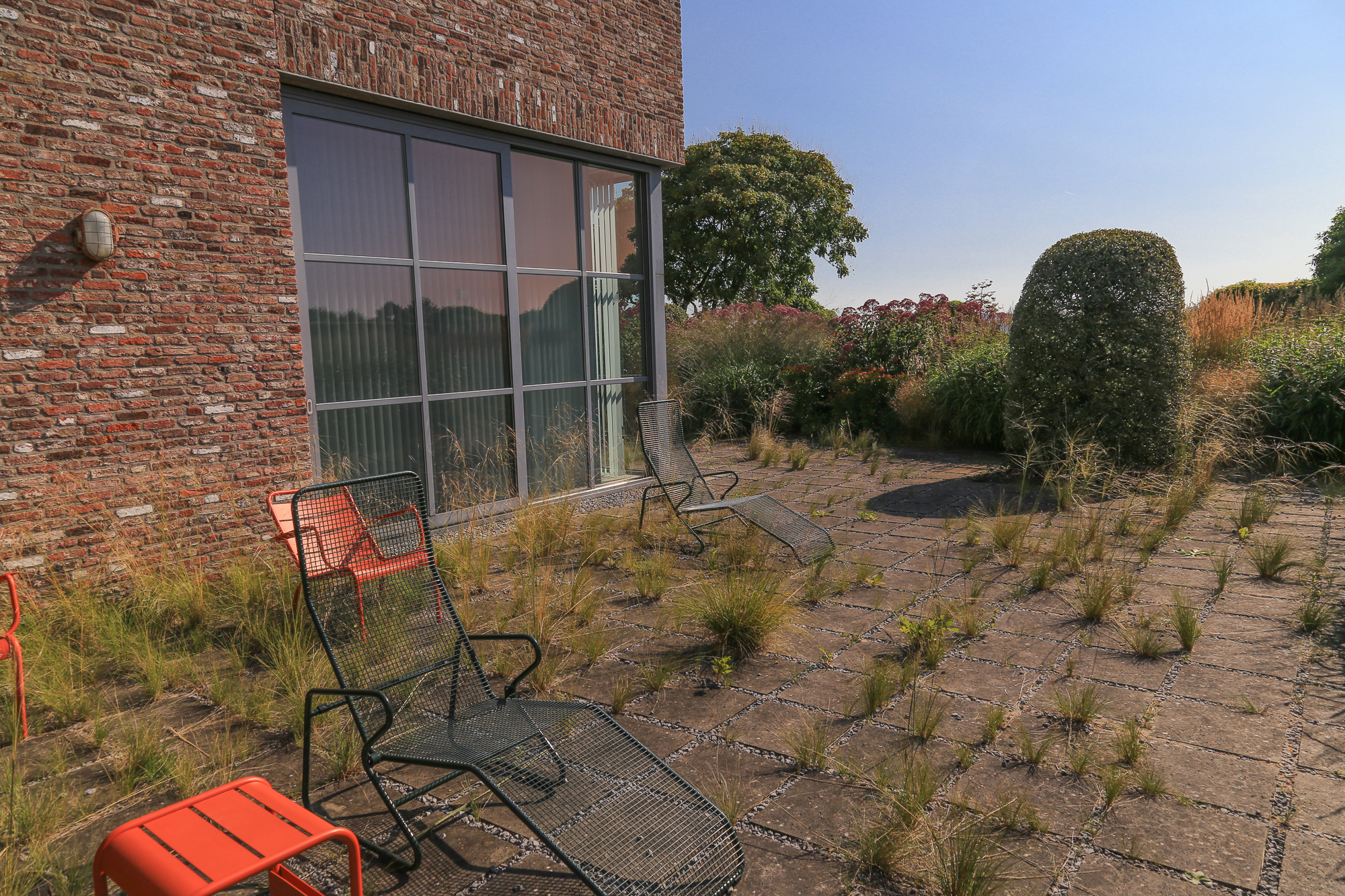 I love that he allows grasses to grow in the cracks between the pavers.Once we were inside his studio, Piet indicated he had something special to show us. He had just finished work on a new meadow garden to be planted at the future Delaware Botanic Garden, and we would be among the first to see the plans. He then laid them on the table before us.
I love that he allows grasses to grow in the cracks between the pavers.Once we were inside his studio, Piet indicated he had something special to show us. He had just finished work on a new meadow garden to be planted at the future Delaware Botanic Garden, and we would be among the first to see the plans. He then laid them on the table before us.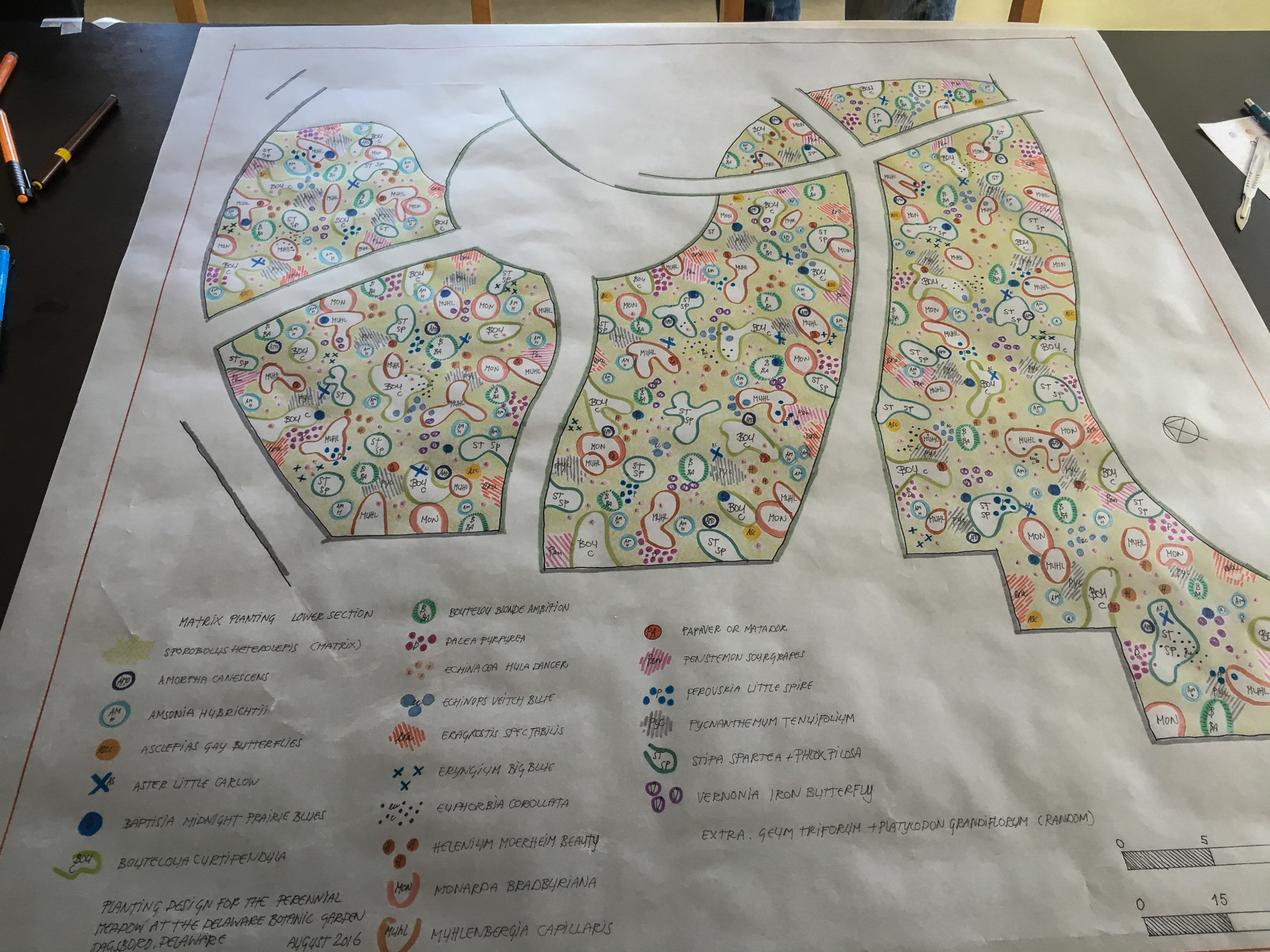 He also tried to give us some impression of his design process by showing us a selection of plant lists and notations ...
He also tried to give us some impression of his design process by showing us a selection of plant lists and notations ... ... and hand drawings to illustrate the evolution of the design process.
... and hand drawings to illustrate the evolution of the design process.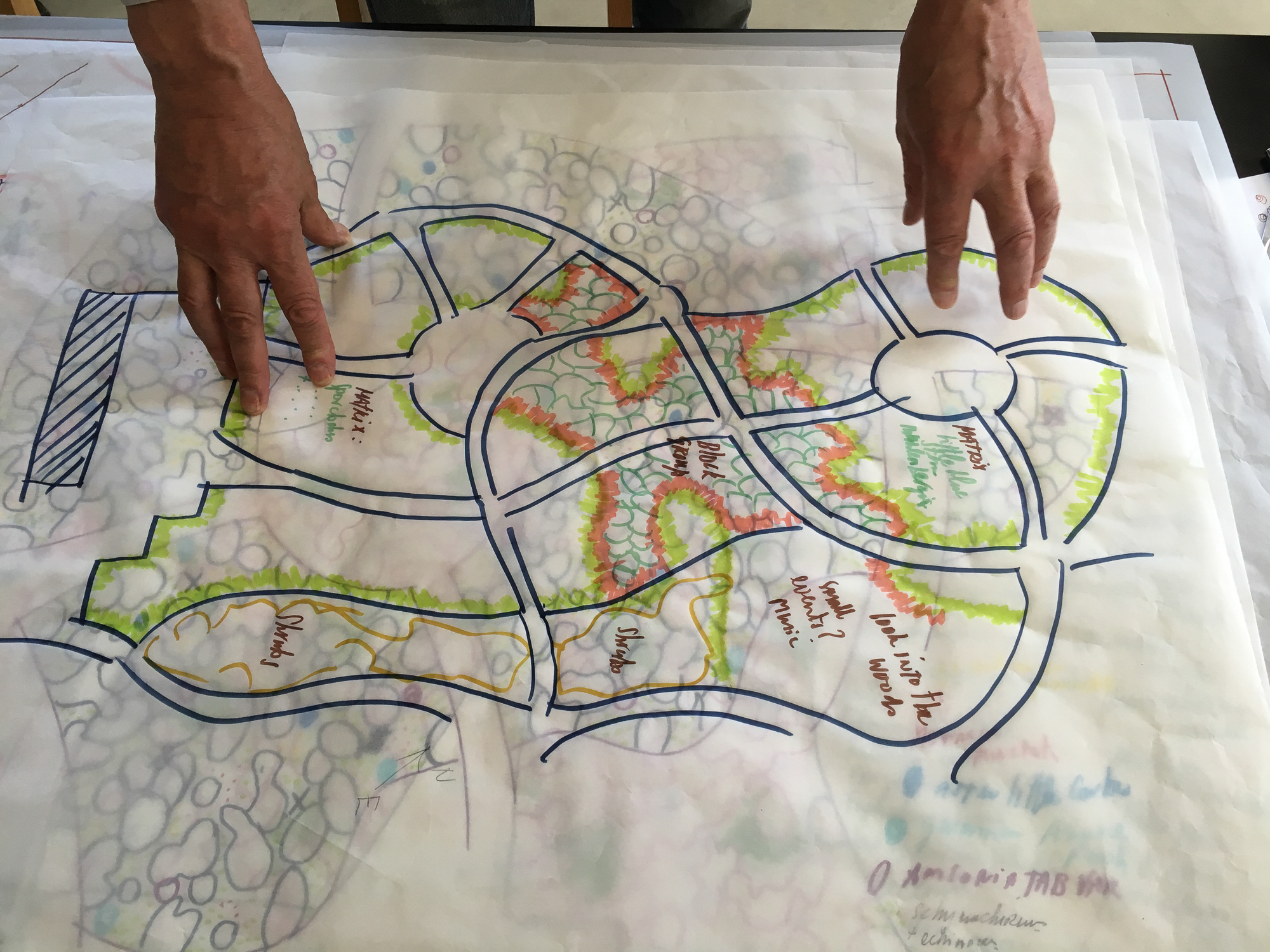
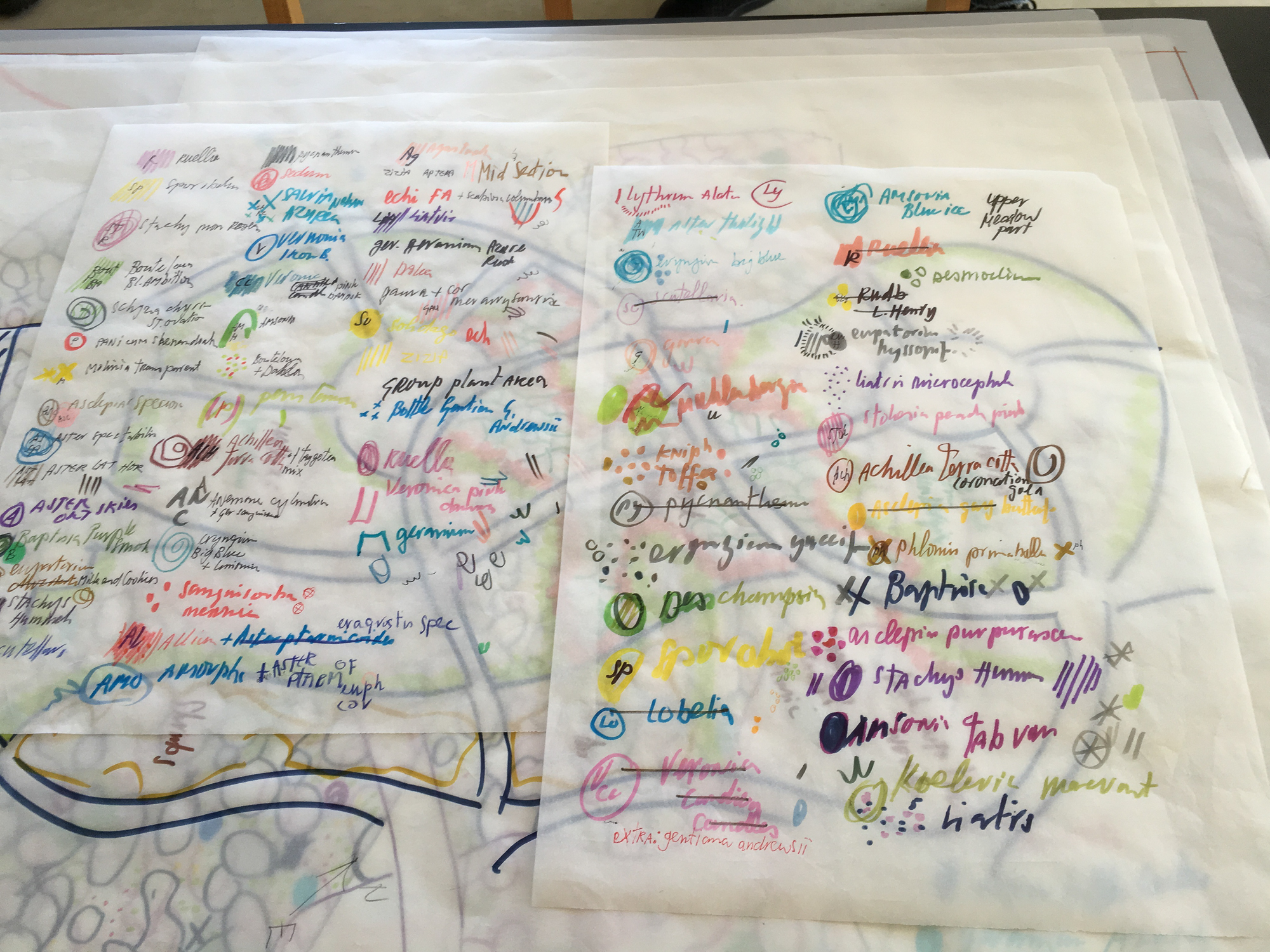
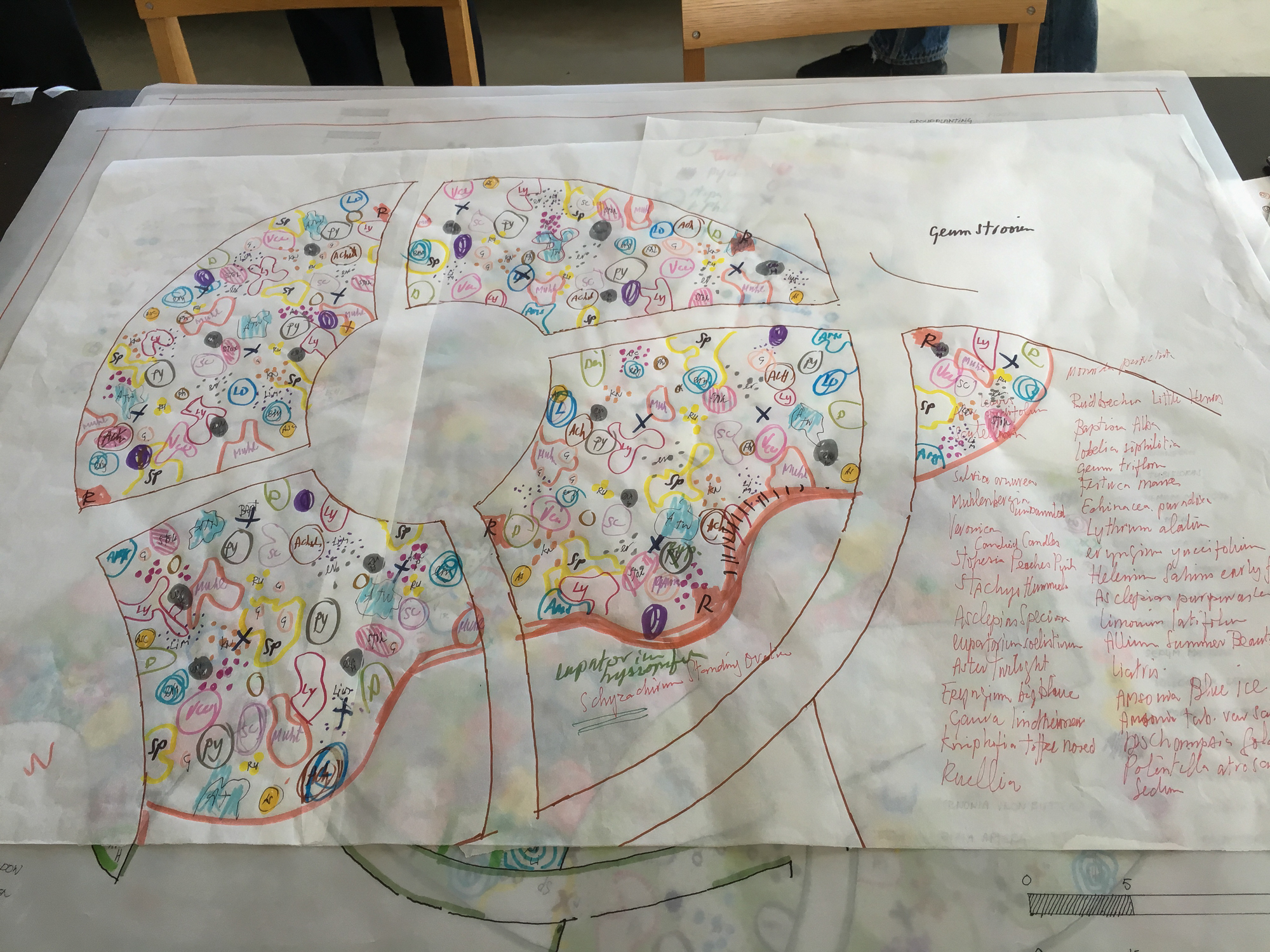 Then he set down at the computer to show us the completion of the process from hand drawn plans to finished designs.
Then he set down at the computer to show us the completion of the process from hand drawn plans to finished designs.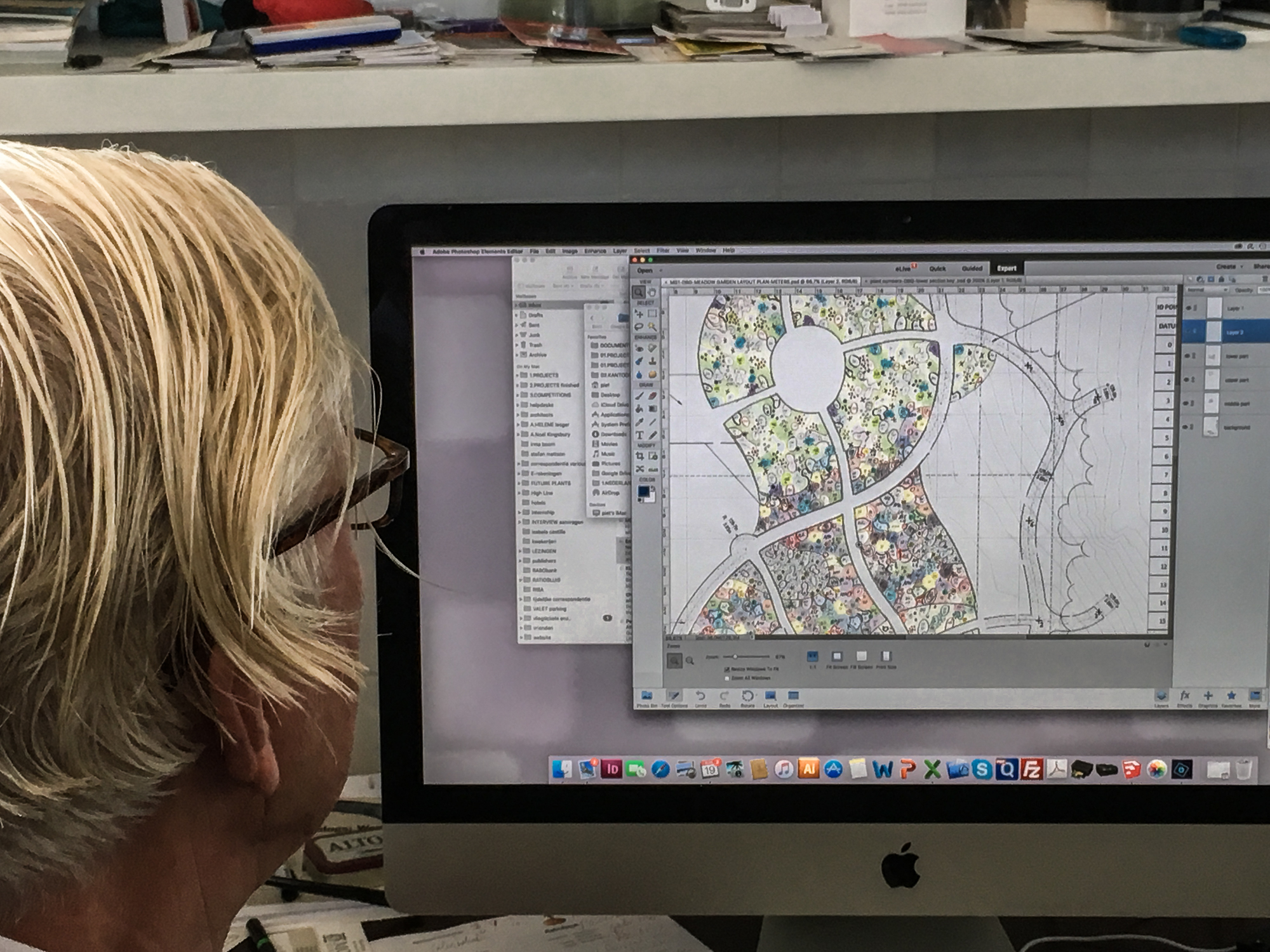 While we were on the roof of the studio, I had noticed other visitors had begun to trickle into the garden. We were no longer alone. So once Piet completed his computer presentation, we said our goodbyes and took our leave, walking the long distance from the studio at the back of the property to the front of the drive to board our coach.
While we were on the roof of the studio, I had noticed other visitors had begun to trickle into the garden. We were no longer alone. So once Piet completed his computer presentation, we said our goodbyes and took our leave, walking the long distance from the studio at the back of the property to the front of the drive to board our coach.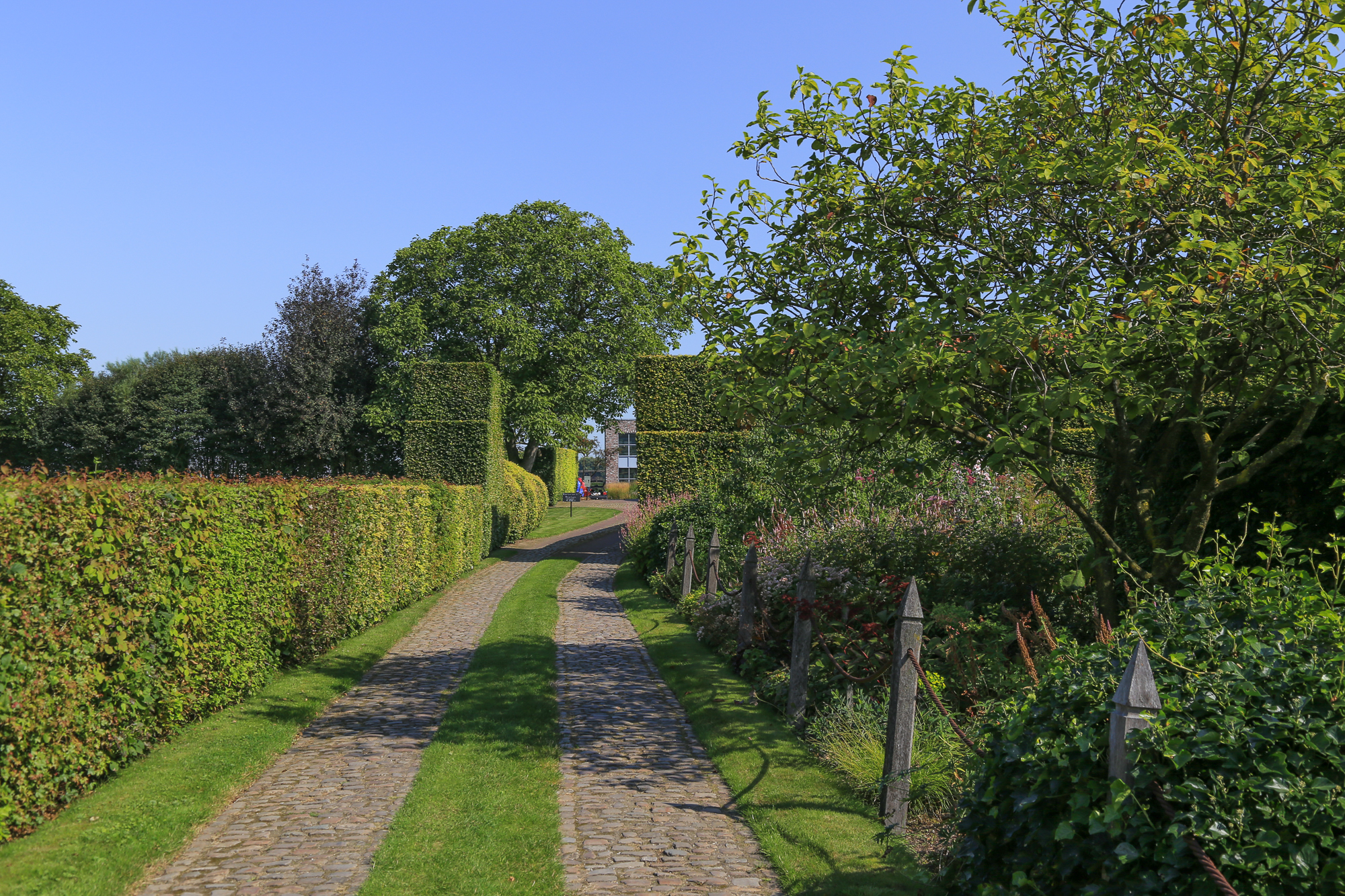 After we boarded, and as the coach pulled away from Piet Oudolf's Hummelo, our band of "Wavers" burst into spontaneous applause! Enough said.
After we boarded, and as the coach pulled away from Piet Oudolf's Hummelo, our band of "Wavers" burst into spontaneous applause! Enough said.